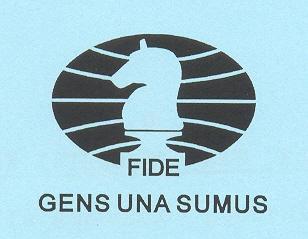
Edward Winter

Section 1: Pre-1924 initiatives to create an international chess federation
Section 2: Foundation of the Fédération Internationale des Echecs (FIDE) and early history
Section 3: Creation of the title FIDE Champion
Section 4: Early involvement of FIDE in the world championship
Section 5: Scotland’s admission to FIDE
Section 6: The Rueb/De Muro affair
Section 7: Euwe world champion for one day
Section 8: Attempts by FIDE to standardize openings nomenclature
Section 9: The readmission of Spain to FIDE
Section 10: The FIDE motto Gens una sumus
Section 11: The FIDE anthem and flag
Section 12: FIDE and the International Olympic Committee (IOC)
Section 13: The second FIDE President, Folke Rogard
Section 14: FIDE awards
Section 15: The Termination of the 1984-85 world championship match
Section 16: FIDE Presidential elections
Section 17: Various
See FIDE: The Prehistory.
In an unexpected written statement to the members of the General Assembly the President of the International Chess Federation announced, as he approached the end of his term of office, that he had decided not to stand for re-election. He also advocated a revision of the rules so that no future President could serve more than one term. In his view, even if such a provision were not introduced it should be observed in practice.
In the long run, he declared, every political programme became conservative because it could not change direction without being weakened. ‘From time to time it is therefore a good policy ... to replace the leaders by others who have new ideas and new possibilities.’ The FIDE President’s announcement concluded by inviting the General Assembly to choose as his replacement an independent figure who was wise, patient and knowledgeable (about people and things).
This statement was made, we omitted to mention, in June 1928. The Dutchman Alexander Rueb had become President four years previously, but now a range of considerations (including ill-health and a declared desire to spend more time at the chess board) had decided him to stand down. It was not to be. The 1928 Congress in The Hague declined his resignation, and Rueb agreed to carry on. He remained President for another two decades.
The source of Rueb’s statement is FIDE’s minutes and other documentation regarding the 1928 General Assembly. The following year, for the Federation’s Congress in Venice, Rueb wrote an account of the period 1928-29 in which he referred to his resignation having been rejected and thanked the General Assembly for its expression of confidence in him. (‘Le Congrès de La Haye ayant nettement refusé d’agréer la démission du Président de la FIDE, il appartient à celui-ci d’exprimer ses remerciements émus à l’Assemblée générale pour cette nouvelle preuve de confiance ...’) Source: the minutes of the General Assembly in Venice, page 2.
‘FIDE was founded in 1924’ say the history books, yet, technically speaking, that could be disputed. Certainly the Fédération Internationale des Echecs was formed that year, but before the 1925 Congress it was systematically referred to it as ‘FIE’, and not ‘FIDE’:
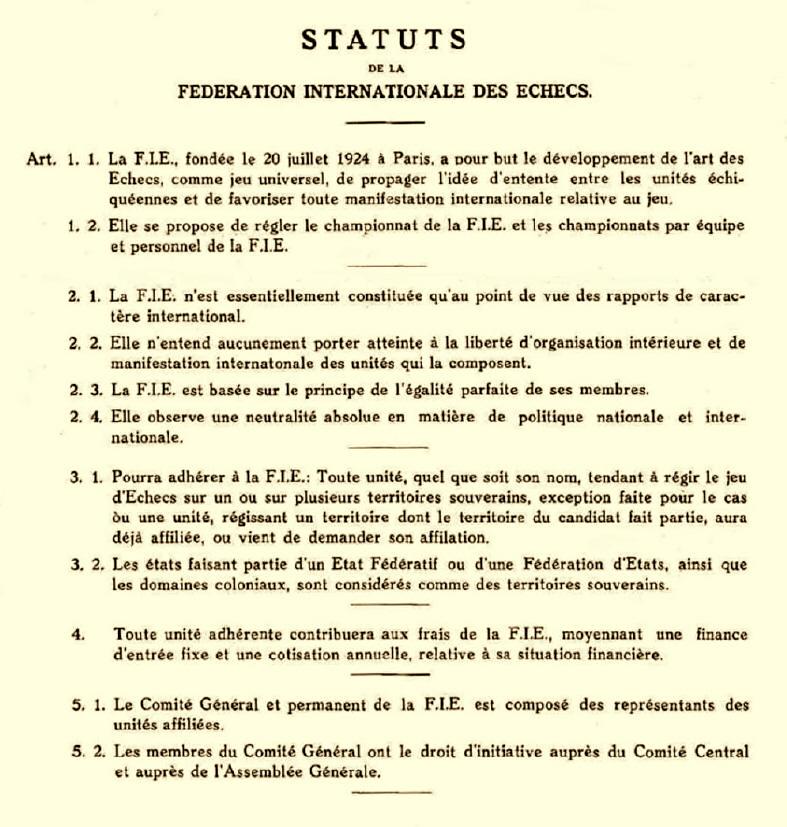
The draft of the Federation’s Statutes as sent to the members for discussion at the 1925 congress.
Throughout the initial period ‘FIE’ was the name also used in other official documents and in press reports; see, for instance, page 149 of the August 1924 Schweizerische Schachzeitung (a report by Marc Nicolet, the Federation’s Treasurer). In spring 1925 Rueb wrote to federations to communicate the programme for the second Congress (Zurich, July 1925), and in that document too ‘FIE’ was used.
Page 24 of the 1973 book Primera Olimpíada de Ajedrez by M.A. Lachaga quoted the October 1949 issue of L’Italia Scacchistica as stating that ‘FIDE’ was proposed by the Italian chess official Alberto Fidi and that Pierre Vincent had remarked, ‘FIDE was christened by Italy’. Indeed, the minutes of the 1925 congress (‘Procès-verbal du congrès, 1925’, page 2) note that during the first session on 23 July 1925, following a request from Italy the abbreviation FIDE was chosen. (‘A la demande de la Délégation Italienne, l'abréviation de Fédération Internationale des Echecs sera représentée par les quatre lettres F.I.D.E. qui composent un mot du plus heureux augure.’).
In Paris in 1924 Rueb took the post of President only until the Zurich Congress, which also amended the Statutes of the re-christened FIDE. This instability suggests that the Federation’s foundation in 1924 had been rushed, and such was the case. It was not until its April 1924 issue (page 93) that La Stratégie had a brief news item inviting national federations to participate in, and to put forward views about, the planned Paris meeting, at which the creation of an international chess federation would be proposed by France:
‘Le Comité organisateur du Tournoi international d’amateurs qui doit se jouer à Paris du 13 au 20 juillet prochain invite les Fédérations étrangères à venir assister à un Congrès le dimanche 20 juillet et les prie de lui faire parvenir à ce sujet leur avis sur l’opportunité de ce congrès et les différents sujets qui pourraient y être traités.
En premier lieu, la Fédération Française des Echecs proposerait la constitution d’une Fédération internationale des Echecs.
Adresser toute la correspondance à M. Fernand Gavarry, ministre plénipotentiaire, président du Comité, 14 rue Alfred-de-Vigny, à Paris (VIIIe).’
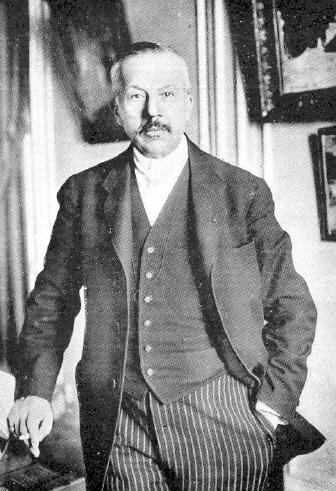
F. Gavarry
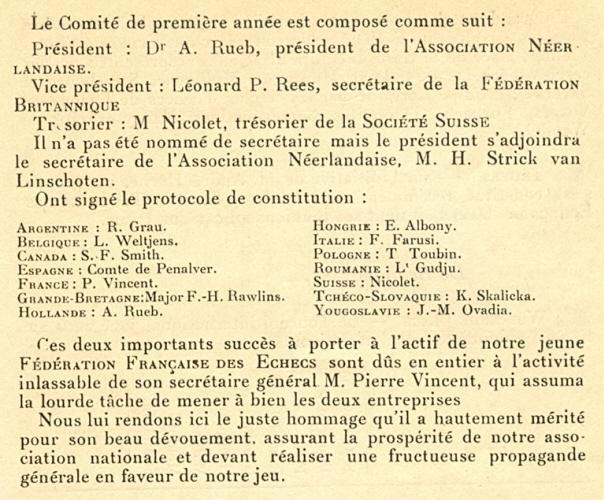
C.N. 7251 mentioned that pages 23-24 of Primera Olimpíada de Ajedrez by M.A. Lachaga (Martínez, 1973) listed 15 signatories: Argentina, Belgium, Canada, Czechoslovakia, Finland, France, Great Britain, Holland, Hungary, Italy, Poland, Romania, Spain, Switzerland and Yugoslavia.
The disrepancy was mentioned by Alfred Maistriaux (Brussels), who asked for further information (e.g. concerning the absence of Finland from the list in La Stratégie).
We noted an official document which compounds the confusion. On page 3 of the minutes (procès-verbal) of the Federation’s second congress (Zurich, 22-26 July 1925) the FIDE President, Alexander Rueb, listed the original signatories, stating that the total had been 15:
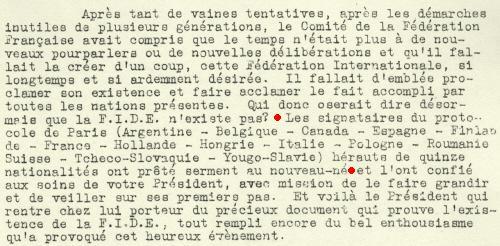
It will be remarked, however, that only 14 countries were named, with Finland among them. Great Britain was omitted, evidently by mistake. (S.J. Holloway and V.L. Wahltuch had been listed on page 1 as Great Britain’s representatives in Zurich.)
It might therefore be tempting to assume that the correct figure for the year 1924 is indeed 15 and that the omission of Finland by La Stratégie was an error. However, page 1 of the procès-verbal stated that before the 1925 Zurich Congress ended two new FIDE members declared themselves, and one of them was Finland:
‘Avant clôture du Congrès ont annoncé leur adhésion:
Correspondence Chess League of America Finlande.’
As reported in C.N. 7282, Luc Winants (Boirs, Belgium) supplied the following account on pages 56-59 of the Bulletin de la Fédération Belge des Echecs, December 1924, which referred to 15 countries (including Finland):
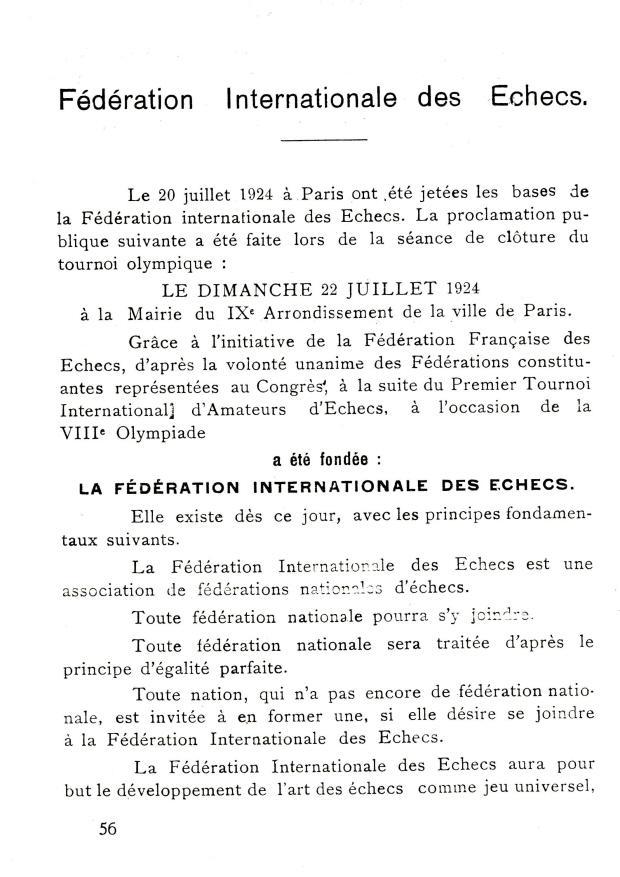
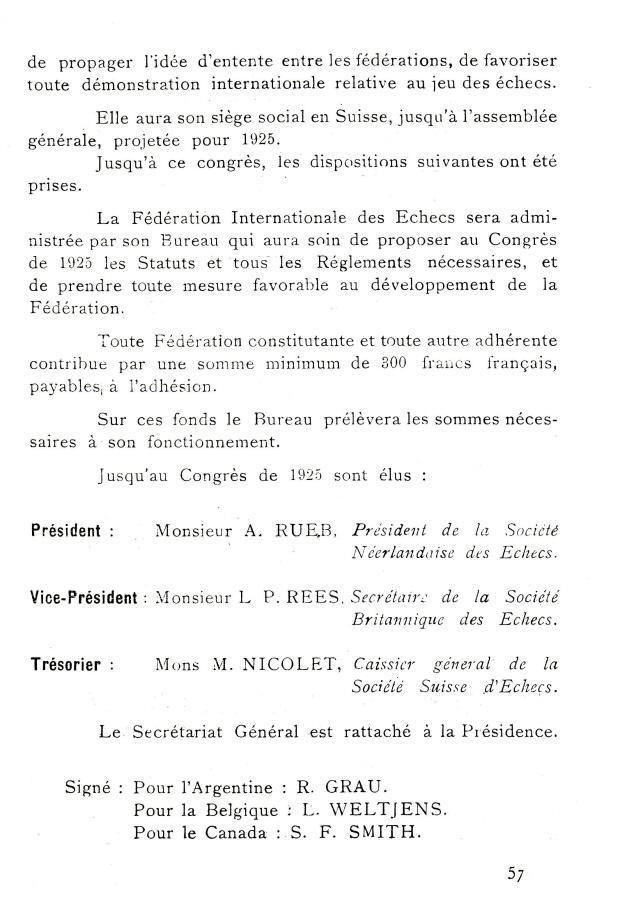
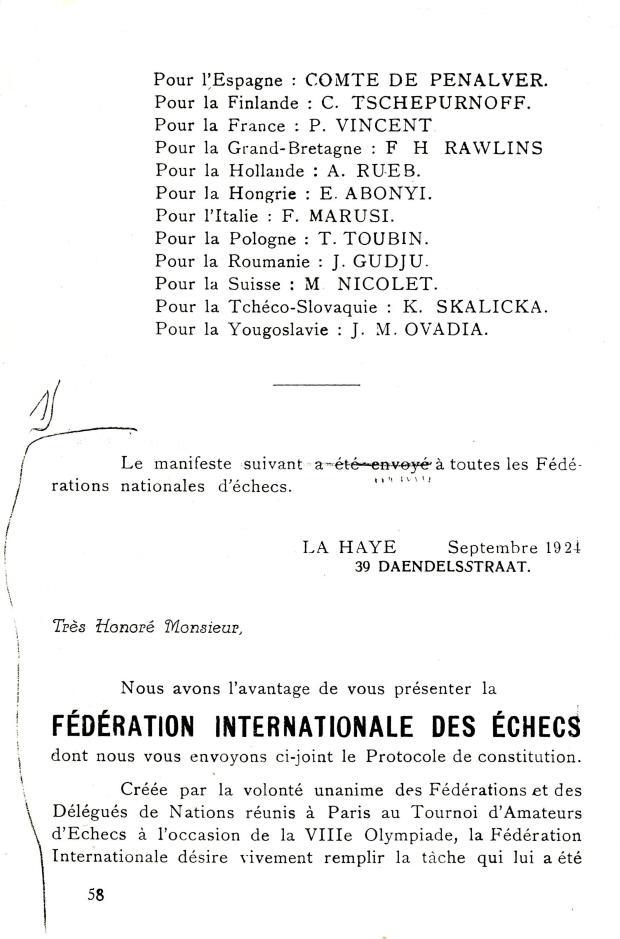
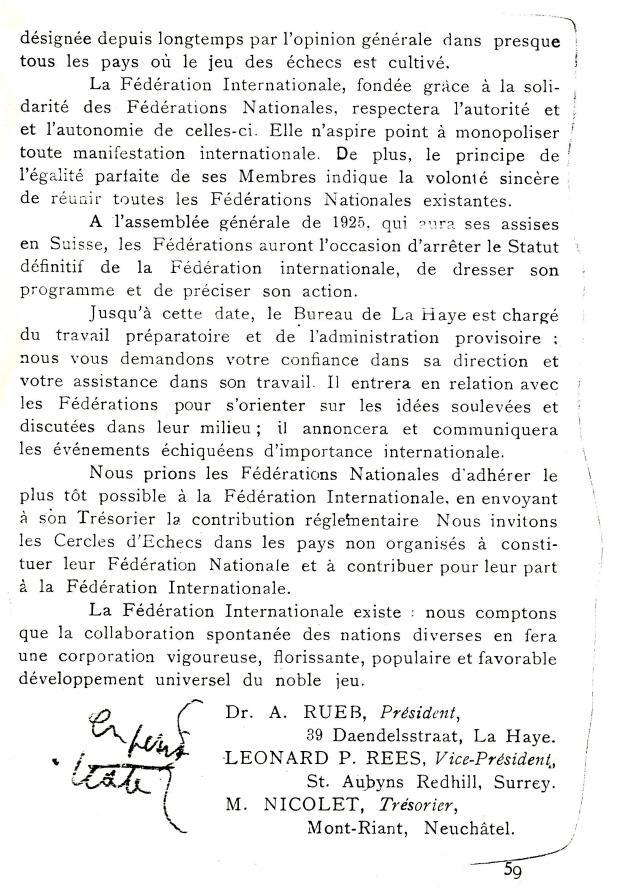
Page 201 of the August 1924 issue of La Stratégie (see above) stated that the success of creating the international federation and having 14 countries sign its draft constitution was entirely due to the work of Pierre Vincent, the Secrétaire général of the French Chess Federation. Vincent is regarded as the founder of the International Chess Federation (see, for instance, page 9 of the 1977 publication Livre d’or de la FIDE), yet few chess reference books say anything about him.

The above photograph of Pierre Vincent (1878-1956) comes from the January 1926 issue of L’Echiquier.
For earlier (1914 and 1920) initiatives to create an international body, see pages 129-130 of Chess Explorations.
Reference books with an entry on Alexander Rueb (1882-1959) tend not to say much about his quarter-century as FIDE’s first President. Even chess history’s broad-sweepists (i.e. those paragons of perspicacious punditry who have seldom, if ever, been in the vicinity of a primary source) appear reluctant to pass judgment on Rueb’s tenure (1924-49), which was marked by the Federation’s creation, its involvement in the world title acrimony between Capablanca and Alekhine, and the reconstruction of the world championship following Alekhine’s demise in 1946. When Rueb himself died, CHESS (March 1959, page 130) wrote that he had ‘played a bigger part than any other man in establishing the present system of world championship contests and qualifying events’. A detailed assessment of the Dutchman’s administrative career remains to be written.
(2828)
A PDF file of the 1925 FIDE Statutes, courtesy of Richard Forster.
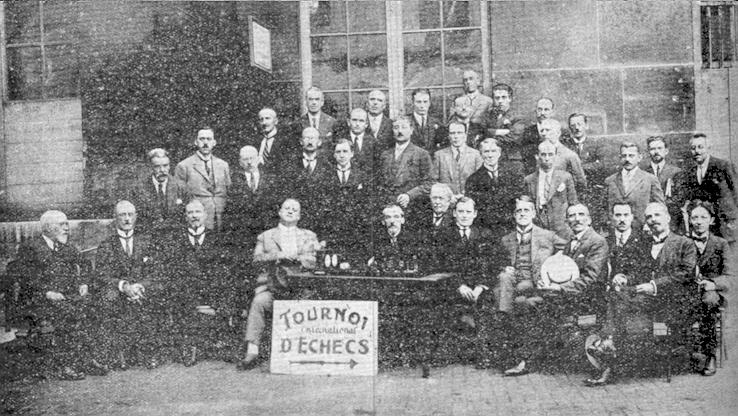
Paris, 1924. A. Rueb is seated fifth from the right, with A. Alekhine on his right
In C.N. 7480 Eduardo Bauzá Mercére (New York, NY, USA) drew attention to a similar picture which was an insert between pages 300 and 301 of El Ajedrez Argentino, September 1924:
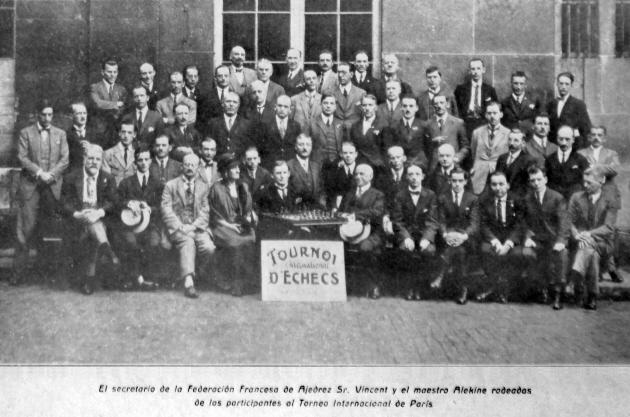
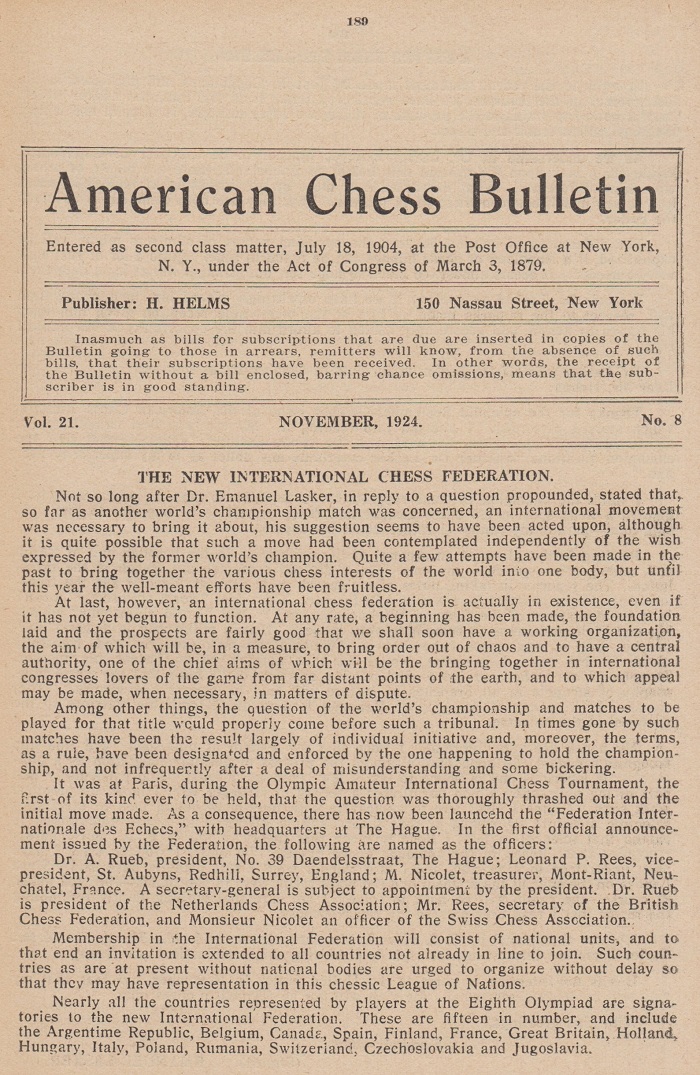
The lack of proper planning for the Paris, 1924 meeting was mentioned by Léon Weltjens of the Belgian Chess Federation in a detailed article about the 1925 Congress in Zurich (L’Echiquier, July 1925, pages 129-132). Weltjens, who had signed the draft constitution for his country, stated that the creation of the international body the previous year had been ‘le résultat d’un moment d’enthousiasme’. In Paris, he wrote, a temporary administration had been set up within just a few minutes, the entire project had been a step into the unknown, the key decisions had been left for the 1925 Congress, and it was now unclear what would remain of the initial excitement. (‘En quelques minutes un bureau provisoire fut formé, et l’on se donna rendez-vous à l’année suivante. L’année suivante, c’était la grande inconnue. Que serait-il resté de l’engouement du premier moment?’)
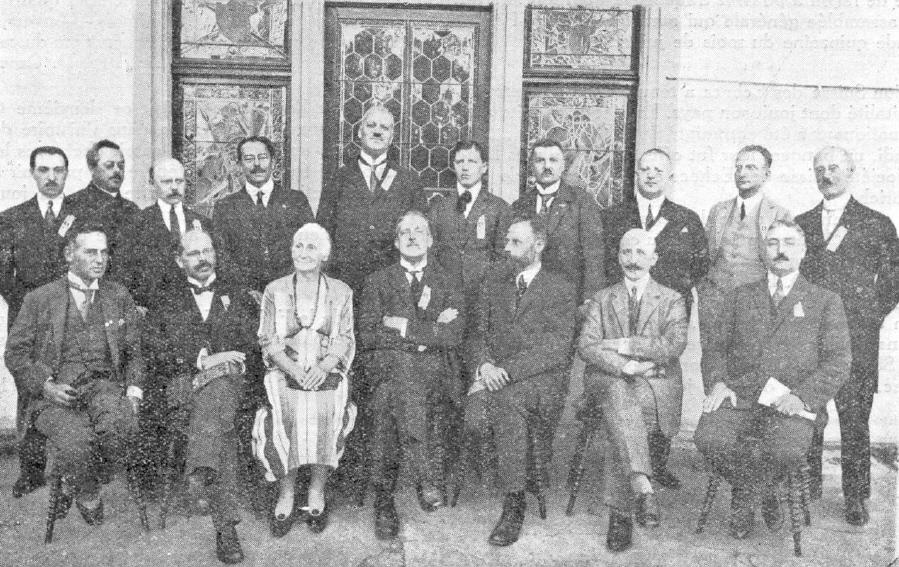
Zurich, 1925
Seated (left to right): V.L. Wahltuch, M. Nicolet, Mrs S.J.
Holloway, A. Rueb, E. Müller, W. Robinow, P. Vincent.
Standing: A. Fidi, C. de Roche, L. Weltjens, E. St John Mildmay,
L. Miliani, I. Gudju, H. Römmig, S. Abonyi, K. de Watteville,
S.J. Holloway
Weltjens also reported in his article in L’Echiquier that the results of the Zurich Congress surpassed expectations and had placed FIDE on a sound footing. Nine Member Federations (or ‘units’ as they were termed) were present. It was agreed that supreme power in FIDE would be vested in the General Committee, which comprised the representatives of the ‘affiliated units’. Management of the Federation was entrusted to a three-member Central Committee: a President, Vice-President and Treasurer of different nationalities. The outgoing post-holders who had taken office provisionally in 1924 (Alexander Rueb of the Netherlands, Leonard Rees of Great Britain and Marc Nicolet of Switzerland) were re-elected by the 1925 General Assembly for three years, by acclamation. Future terms of office, it was decided, would be two [sic] years. [That figure was indeed stated by the report in L’Echiquier, but it appears to be an error, i.e. the digit 2 instead of 4.]
Rueb was re-elected in Paris, 1932 and Lucerne, 1936. Because of the War, the next FIDE Congress at which the issue of the Presidency arose was in 1946, in Winterthur. (See pages 91-92 of Chess Facts and Fables and, for a group photograph, C.N. 3821.) Rueb was re-elected yet again, but at the 1948 Congress in Saltsjöbaden he announced his intention of stepping down.
A photograph from page 271 of CHESS, September 1948:
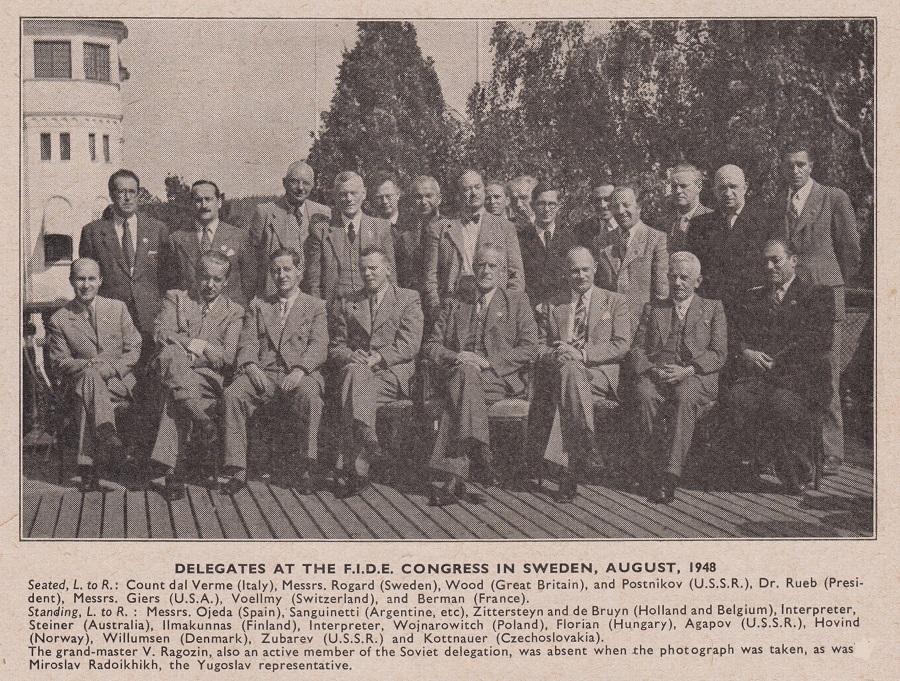
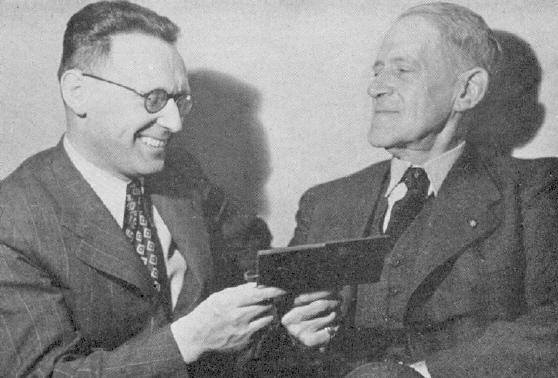
M. Botvinnik and A. Rueb in 1948
At the proposal of Folke Rogard, a Vice-President from Sweden, it was agreed at the 1948 Congress that Rueb would continue in office until the following year, and at the 1949 General Assembly in Paris Rogard was elected President almost unanimously. Rueb, who had headed the Federation for a quarter of a century, became Honorary President. He died in 1959 at the age of 76.
(4363)
A photograph taken during the Paris, 1949 FIDE Congress which shows Botvinnik was given in the plate section between pages 256 and 257 of volume two of Botvinnik’s Best Games (Olomouc, 2000).
Coverage of the 1925 FIDE Congress appeared on pages 170-171 of L’Italia Scacchistica, September 1925:
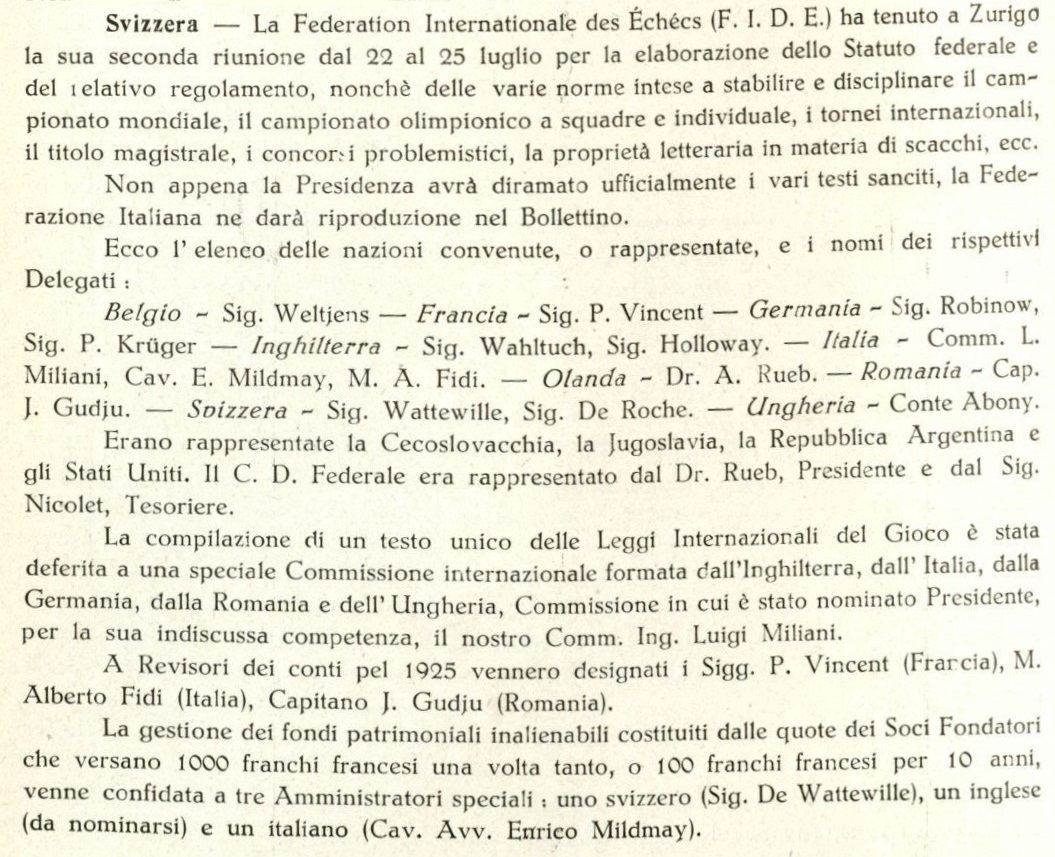
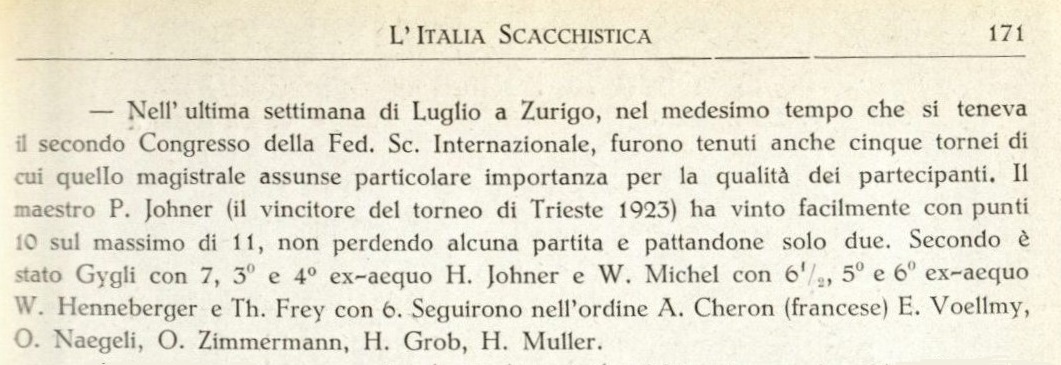
The above two pages have been provided by the Cleveland Public Library.
’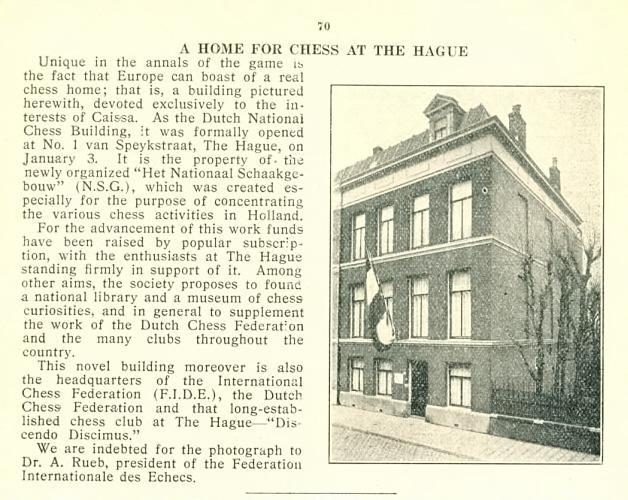
American Chess Bulletin, March 1927, page 70
Harrie Grondijs (Rijswijk, the Netherlands) has sent us the photograph below, taken on 31 July 2007:
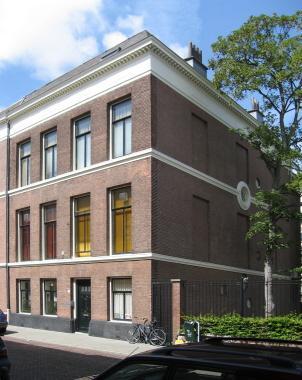
(5091)
In a letter dated 9 July 1945 to the Schweizerische Schachzeitung (November 1945 issue, page 169) the FIDE President, Alexander Rueb, reported that a fire had destroyed the Federation’s archives and much else:
‘Nous avons survécu, ma femme, mes trois fils et moi. Mais un désastre, le 3 mars 1945! Chassés de la van Speykstraat, la Fédération néerlandaise et moi avions transporté nos biens ailleurs en janvier 1944, mais 15 mois plus tard le quartier fut la proie des flammes. Tout l’inventaire de la Fédération, sa précieuese bibliothèque, ses collections et ses souvenirs ont péri! En outre, les archives de la FIDE, mon étude d’avocat ... l’oeuvre de ma vie! Heureusement, ma collection privée d’études est sauvée. Je n’ai pas perdu courage et reprendrai l’oeuvre de la FIDE aussi tôt que possible. Mon adresse: 43 Riouwstraat, La Haye.’
(8089)
The first player to be recognized by FIDE as world champion was Capablanca, in 1925.
Below is an excerpt from the report by Alexander Rueb, the FIDE President, to the Federation’s 1928 Congress in The Hague (page 4 of the Compte-Rendu):
‘A peine les derniers échos du grand congrès de Londres s’étaient tus qu’un nouvel événement échiquien d’une énorme importance s’est annoncé; sur l’initiative d’amis des échecs de l’Amérique du Sud de Buenos-Aires a eu lieu le match pour le championnat du monde.
Ce fait ne regardait la FIDE qu’en tant qu’elle avait reconnu officiellement à Zürich en 1925 M. Capablanca comme détenteur du titre. Pour le reste elle n’a joué aucun rôle dans l’arrangement de cette épreuve.’
(4077)
An observation by R.C. Griffith on page 155 of the April 1932 BCM:
‘It is most unfortunate that there always seems to be bickering between reigning and past champions. This has been the case for many decades, and it is for this reason that we so strongly advocate that the arrangements for the championship should be in the hands of the FIDE. If the patrons of chess who help to put up the necessary finance would agree that they would only do so through the FIDE, it is possible that our suggestion may be practical politics earlier than we anticipate.’
(2407)
Much documentation on FIDE’s involvement in the world championship after Alekhine won the title in 1927 is supplied on pages 207-241 of our monograph on Capablanca.
With regard to world championship affairs from the late 1930s onwards, see too World Championship Disorder. An account of the action taken by the Federation following the death of Alekhine in 1946 appears in Interregnum.
Information about the creation of the woman’s world championship, first won by Vera Menchik in London in 1927, is given in C.N. 9074.
From page 115 of CHESS, March 1946:
‘Botvinnik has written Mr Derbyshire, President of the British Chess Federation, saying that the Moscow Chess Club is willing to sponsor a world championship match Botvinnik v Alekhine and put up 10,000 dollars (£2,500). Two-thirds to go to the winner and the balance to be allocated to expenses. The BCF to organize the entire match. Mr Derbyshire is planning to commence the match during the tournament at Nottingham in August.’
From page 143 of CHESS, April 1946:
‘Alekhine has accepted Botvinnik’s challenge to a world championship match, subject to the conditions being the same as those under which he was negotiating to play Botvinnik in 1939. The British Chess Federation will be asked at its Executive meeting on 26 March whether it is willing to accept responsibility for organizing the event.’
From page 168 of CHESS, May 1946:
‘After considerable discussion, the BCF agreed to organize the Alekhine-Botvinnik match, but only because no effective International Chess Federation was in effective existence and only on condition that both players should bind themselves to submit to the ruling of such a Federation in connection with the next following match.
(Next day, Alekhine’s death was announced.)’
From page 342 of the August 1932 BCM:
‘We were extremely pleased to hear that at the recent annual meeting of the FIDE at Paris, Scotland was admitted to membership. We extend a cordial hand of welcome to our Northern friends, and shall look forward to seeing a Scottish team competing in the Team Tournament for the Hamilton-Russell Cup at Folkestone next June.’
Two years previously the Scottish Chess Association had proposed leaving the British Chess Federation and joining FIDE, but its application was unanimously rejected (8-0) by FIDE delegates, with Germany, Belgium, Great Britain and the Netherlands abstaining and the British Chess Federation expressing absolute neutrality:
‘La candidature de la Fédération écossaise, qui se propose de quitter la British Chess Federation, donne lieu à une discussion. Elle est repoussée par 8 voix contre 0, avec abstentions (Allemagne, Belgique, Grande-Bretagne, Pays-Bas), le délégué de la Grande-Bretagne ayant déclaré que sa Fédération adoptait la plus stricte neutralité dans cette affaire.’
Source: Procès-verbal du VIIe Congrès, Hambourg, 23-26 juillet 1930 (The Hague, 1931), page 8.
Two years later, a fresh application was made by Scotland. The FIDE President, Alexander Rueb, set up a small Commission in which he was joined by W. Robinow (Germany) and E. St John Mildmay (Italy). The group reported favourably on Scotland’s candidacy, which was then accepted unanimously by delegates (with Great Britain abstaining):
‘Demande de filiation de la Fédération nationale de l’Ecosse
Cette fédération présente à nouveau sa demande d’admission dans la FIDE; la British Chess Federation se déclare neutre pour cette question; afin de ne pas prendre de décision contraire aux statuts, Monsieur le Président propose le renvoi à une Commission qui rapportera à la séance de relevée; cette commission est composée de MM. Rueb, Robinow et Mildmay.
La Commission rapporte favorablement; l’admission est votée à l’unanimité sauf la Grande-Bretagne; le délégué de la Brit. Chess Federation s’abstient mais confirme la neutralité de sa fédération.’
Source: Procès-verbal du IXe Congrès à Paris, 18-20 juillet 1932 (The Hague, 1932), page 4.
The British Chess Federation’s delegate on both occasions was Victor Wahltuch.
(5642)
In 1939 the President of the Argentine Chess Federation, Augusto de Muro, was involved in negotiations for a rematch between Alekhine and Capablanca. Page 240 of our monograph on the Cuban reproduced the letters sent to de Muro by Capablanca and Alekhine on, respectively, 16 and 18 September 1939. See too C.N. 4696.
From C.N. 10573:
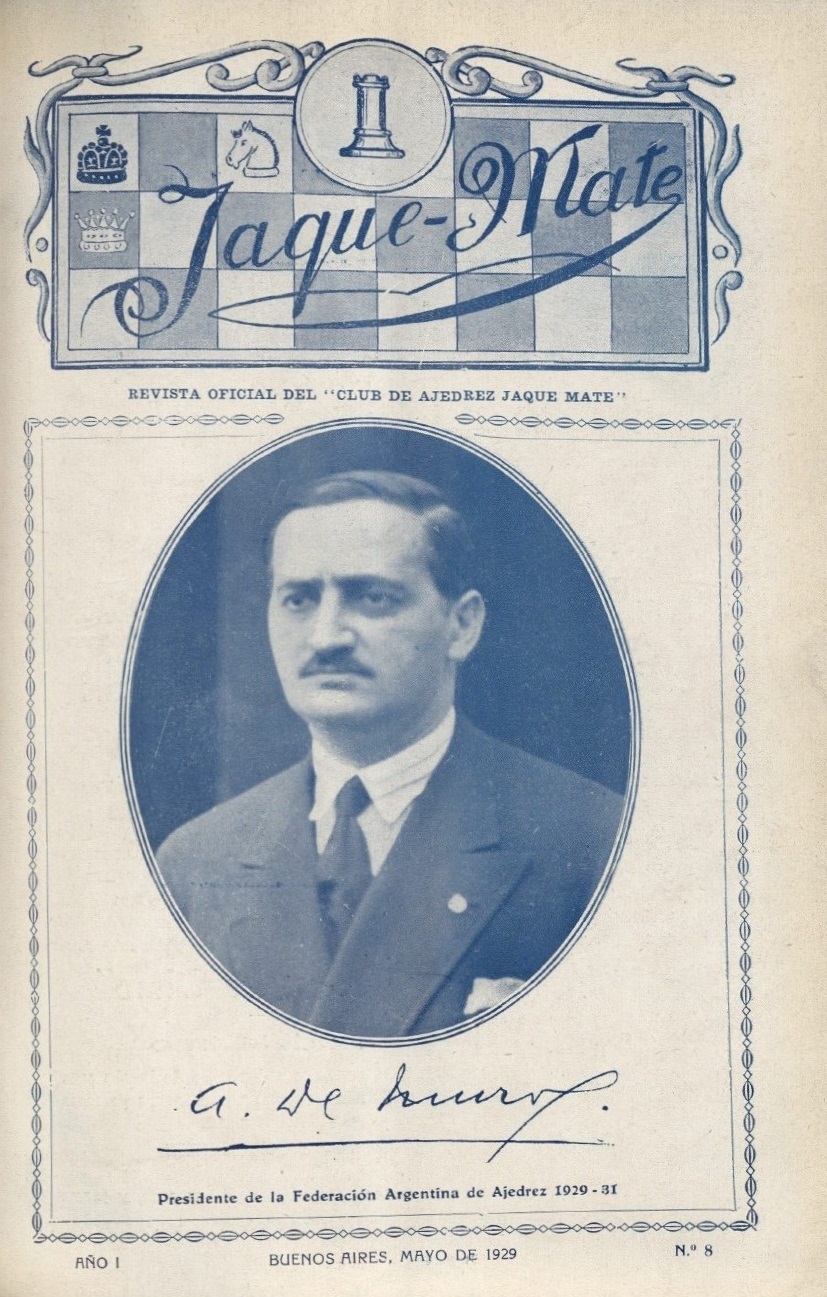
We now note that a group within FIDE is proposing that, subject to further investigation, Augusto de Muro should be recognized as the second President of FIDE, for the period 1939/40 until 1946, i.e. an interruption of Alexander Rueb’s tenure (currently regarded as lasting from 1924 to 1949).
Any investigation of such an historical issue is to be welcomed if conducted with rigour and free of nationalistic considerations.
The article includes the following (text reproduced as it stands):
‘The next FIDE Congress was held seven years later, between July 25 and 27, 1946 in Winterthur (Switzerland), where only 9 delegates attended, in the absence of all the Latin American delegations. There Mr Rueb was once again appointed President of FIDE without referring to the corresponding transfer of command – from Mr De Muro to Mr Rueb – and resuming the mandate as indicated by the well-known historical line of time, assuming the presidential period 1924-1946 without interruptions, which clearly it does not adjust to what really happened and ignoring the decisions adopted by the previous Congress of the entity held in Buenos Aires 1939.
Let us remember that Mr Erwin Voellmy stated that: “during the war period, no European Federation made contributions to the entity, with the exception of Denmark, so FIDE had practically ceased to exist”. Also, who was a Swiss delegate in several Congresses, pointed out that FIDE did not hold congresses from 1940 to 1945. In this European perspective, which does not seem to consider what was done in the American continent by the President of the legal FIDE, Mr Augusto de Muro, the supposed mandate that Mr Rueb would have had should cease immediately from that year of 1940.
In this line of analysis the historian Mr Edward Winter coined the term “interregnum” to refer to FIDE’s actions during the armed conflict, denoting its inaction, but that is worth, we insist, only from a perspective focused on a Europe that was the central stage of the world conflict, but not considering what was done in America since the representation of the world entity as decided in 1939.
Therefore, it is fitting that Mr Augusto De Muro be included as President of FIDE for the period 1939/1946. Before and after, in the gallery of former Presidents of the entity, Mr Alexander Rueb must appear. In this way, a historical fact will be recognized that we have called, alluding to the Argentine, “the unqu[e]stionable President of FIDE”.’
The reference to us in the third paragraph above is based on an evident misunderstanding. Our Interregnum feature article focuses on the period from Alekhine’s death in 1946 to the 1948 match-tournament in The Hague and Moscow, and not on the Presidency of FIDE during the first half of the 1940s.
(11915)
C.N. 11915 reported an announcement in October 2022 that a group within FIDE was investigating the possible grounds for declaring that Alexander Rueb should no longer be regarded as the Federation’s President for the period 1939/40-1946. The key issue is whether events during the 1939 Session of the FIDE General Assembly in Buenos Aires justify a proposal that, for the wartime years, the FIDE President should in future be recorded as Augusto De Muro of Argentina. (Henceforth we shall capitalize ‘De’, the evidence in favour of ‘de’ being ever weaker.)
Richard Forster (Winterthur, Switzerland) has now researched the 1939 General Assembly in depth and has written a detailed analysis, together with his conclusions as to whether or not Augusto De Muro’s name should be added, retrospectively, to the roll-call of FIDE Presidents. See FIDE Chess Congress 1939: An Investigation.
Moreover, for our website Dr Forster has produced a briefer account, entitled Coup or Call of Duty? Commotion at the 1939 FIDE Chess Congress.
(11918)
On the question of whether Augusto De Muro, and not Alexander Rueb, should in future be recorded as the President of FIDE during the period 1939/1946, Richard Forster has added a postscript to his Coup or Call of Duty? article. He addresses some of the arguments advanced recently by those advocating that De Muro should indeed be added to the official list of FIDE Presidents.
(11925)
Our earlier items have referred to a current discussion within FIDE concerning Alexander Rueb’s tenure of the presidency, with links to FIDE Chess Congress 1939: An Investigation by Richard Forster and to his briefer account, entitled Coup or Call of Duty? Commotion at the 1939 FIDE Chess Congress.
Pages 40-42 of the February 2023 CHESS feature a further article by Dr Forster, ‘Buenos Aires 1939: The putsch that did not happen’. The three-page article is shown here with the permission of CHESS.
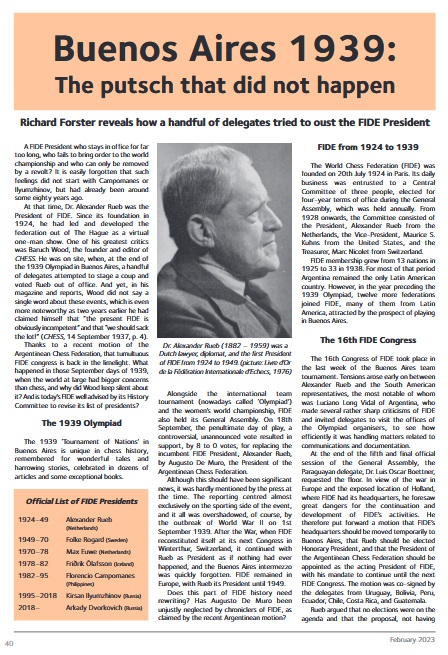
(11935)
Addition on 25 March 2023:
The matter is due to be considered by the FIDE Council in Mexico City on 4 April 2023, and we see only one possible conclusion: there would be no justification for adding Augusto De Muro’s name, in any way, to the roll-call of FIDE Presidents. Alexander Rueb was the President for the entire period 1924-49.
Addition on 29 April 2023:
From the ‘List of decisions’ at the above-mentioned FIDE meeting:
‘CM1-2023/46 FIDE recognizes that Dr Augusto de Muro was appointed as FIDE President by the FIDE General Assembly in Buenos Aires, 1939. FIDE notes that Dr Augusto de Muro’s appointment was later contested by the previous administration and he was not executing the duties during the war.’
Addition on 10 September 2023:
It is regrettable that FIDE handled the matter with scant historical rigour, concluding with a foggy text in poor English.
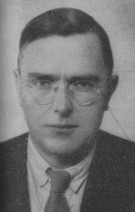
Max Euwe
Glenn Giffen (Toronto, Canada) and Mark Weeks (Brussels, Belgium) raise the subject of the ‘champion for one day’ claims sometimes seen regarding Euwe, and for readers’ convenience we revert here to C.N. 3321, where Christian Sánchez (Rosario, Argentina) wrote:
‘I have repeatedly read that in 1947 Euwe was champion for one day; for instance, page 127 of the second edition of The Oxford Companion to Chess says:
“With the death of Alekhine in 1946 the world championship title was vacant. To deal with the matter FIDE delegates assembled in 1947, and at the same meeting the Soviet Union became a member. The delegates decided that Euwe, as the previous title-holder, and indeed the only ex-champion still alive, should become world champion pending the next contest. The next day the Soviet contingent arrived, having been delayed en route, had the decision annulled, and the title left vacant. Thus he would say wryly that he had been world champion for one day in 1947.”
However, according to the minutes of the FIDE Congress, that decision was never taken. Below is the Spanish version of the two reports on the sessions of 1 and 2 August 1947 respectively, as published in El Ajedrez Argentino, November-December, 1947, pages 298-300):
“La cuestión del Campeonato del mundo se discute y después de votación de diversos proyectos se inclinan los delegados, cuando el Dr. Euwe abandonó la sesión, a la proclamación del mismo como Campeón del mundo con la obligación de jugar un match con Reshevsky y luego el ganador de enfrentarse con Botvinnik. Sres. Louma y Rogard juzgan esta determinación como peligrosa en vista de la ausencia del delegado soviético y proponen aplazar la resolución en espera de la Delegación de la U.R.S.S. Esta proposición fue aceptada.”
“Presentes los mismos Delegados de la sesión anterior y los Delegados soviéticos señores Pochegnikov, Ragozin y Yudovich y el intérprete S. Malolev. (...) Luego se discute la reglamentación del Campeonato del mundo. Se acepta por unanimidad jugar un torneo de seis grandes maestros como fue fijado en la Asamblea General de Winterthur, 1946. El torneo se inicia el 1º de marzo de 1948 en Holanda jugándose allí la mitad del torneo. Después de un intervalo de 15 días como máximum se jugará la segunda mitad del torneo en URSS de modo que el torneo terminará el 31 de mayo de 1948. El torneo se jugará entre los maestros designados y presentes al iniciarlo y en el caso de que no se llevara a cabo decidirá la Asamblea General próxima otro reglamento.”’
In expressing gratitude to Mr Sánchez for these quotes, C.N. 3321 commented that we had been unable to find an English version of the minutes of FIDE’s 1947 Congress (which remains the case today). The first passage above states that after Euwe left the room the delegates decided to proclaim him world champion, but with an obligation upon him to play a match against Reshevsky and with the winner of that match then having to play Botvinnik. However, Messrs Louma and Rogard regarded this proposal as dangerous in view of the absence of the members of the Soviet delegation, and it was decided to postpone the resolution, pending their arrival. The second text above states that after they had come the following day the six-man match-tournament was agreed upon.
C.N. 3321 furthermore requested substantiation (not yet found) for the statement in The Companion that Euwe himself ‘would say wryly that he had been world champion for one day in 1947’ and for the assertion on pages 270-271 of Max Euwe by Alexander Münninghoff (Alkmaar, 2001) that in 1947 ‘Euwe was world champion for two hours’. We also wondered about the identity, and even existence, of the ‘someone’ on page 9 of part two of Garry Kasparov on My Great Predecessors (London, 2003):
‘Euwe held the crown for only two years (1935-37), and someone once christened him “king for a day”, in view of Alekhine’s indifferent form.’
(3816)
If a game begins 1 d4 d5 2 e3, a book or magazine is likely to have a heading (sometimes more prominent than the players’ names) ‘Queen’s Pawn Game’, ‘Queen’s Pawn Opening’ or ‘Queen’s Pawn’. These are innocuously interchangeable terms, but many openings offer the prospect of confusion and controversy. Not everybody is happy to call 1 e4 e6 2 d4 d5 3 Nc3 Bb4 the Winawer Variation or, even, to accept that 1 e4 Nf6 is Alekhine’s Defence. Nor is there any consensus on how far down the branches the tagging should continue. (Surely, though, not as far as 16...g3, which is the start of the ‘Utica Variation’ in the Rice Gambit Accepted.)
A relaxed attitude to openings nomenclature usually prevails, and it is difficult not to have mixed feelings about the entire subject. Consistency is desirable, but absolute uniformity is impossible. Order is wanted, but not regimentation. Historical priority is important, but not necessarily decisive. National considerations may play a role, but should not be excessive or jingoistic. Any player or analyst can risk ridicule by unilaterally christening an opening after himself or through recourse to soppy levity, but it is posterity that will decide, to the extent that it decides anything in chess. Opening codes may be seen as offering a safer, more coherent framework, but terms such as the ‘Dutch Defence’, ‘Falkbeer Counter Gambit’ and ‘Giuoco Piano’ are part of the culture and charm of chess.
About 75 years ago, a project was launched to standardize terminology. It resulted from an initiative within FIDE by Czechoslovakia to combat confusion by producing a properly thought-out list of openings. This grand design was recorded on page 12 of the minutes of FIDE’s Procès-verbal du VIe Congrès (Venice, 26-30 September 1929):
‘Les délégués de la Fédération tchécoslovaque soumettent le voeu que la FIDE s’emploie à dresser une liste raisonnée des débuts de partie, des variantes et des défenses, étant donné qu’il existe actuellement dans ce domaine une confusion malencontreuse.’
The delegates from Czechoslovakia agreed to draw up a draft by 1 April 1930. At that year’s FIDE Congress, in Hamburg, a committee was set up (involving the federations of Czechoslovakia, Germany, Holland, Poland and Sweden) to prepare by the following year a report on the draft (source: FIDE minutes of the 1930 Congress, page 18). In the summer of 1931 FIDE met in Prague and, as noted on page 7 of the minutes, the Secretary of the Czechoslovakian Federation, Josef Louma, reported that the draft had been revised by a large number of chess figures, including Tartakower and Grünfeld. Another year went by. Page 9 of the minutes of the Paris, 1932 Congress contained a brief note by the FIDE President, Alexander Rueb, that no further news was available on the openings project (which was described as ‘important mais difficile et considérable’. But then at Folkestone in 1933 the delegate from Czechoslovakia, Jan Bedrníček, presented a document by Louma, still described as a draft (‘avant-projet’). Rueb extended his warm congratulations, and the minutes (page 4) also reported that the work would be published, at FIDE’s expense, with profits going into the FIDE coffers. A further year passed, and it was not until the Zurich Congress in 1934 that, as noted on page 5 of the minutes, FIDE was able to announce with great pleasure that the book had just appeared:
‘Nous sommes infiniment heureux d’annoncer la terminaison du grand travail de classification des débuts de partie, dont s’était chargée la Fédération tchécoslovaque. Ce travail vient de paraître ...’
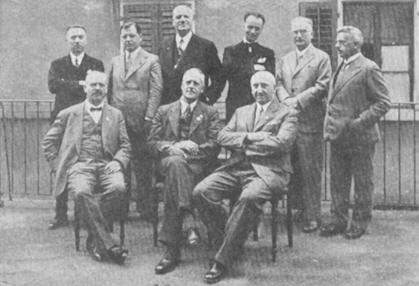
FIDE officials in Zurich, 1934. Seated (left to right): M. Nicolet, A. Rueb and J. Bedrníček. Standing: A. Fidi, I. Gudju, L. Miliani, C. Leu, C. de Watteville and E.Voellmy
The product of half a decade’s exertion, or inertia, was a 54-page booklet Débuts du jeu d’échecs with the subtitle ‘Leur désignation uniforme’, published in Prague by officials of the Czechoslovakian Federation and revised by a Committee comprising Rueb, Przepiórka, Collijn, Grünfeld and Tartakower. Rueb’s introduction (page 6) described it as a first attempt at consistency (‘un premier effort vers la stabilisation de la nomenclature des débuts’) which did not claim to be complete, infallible or conclusive. Indeed, the term ‘avant-projet’ was still employed. A Preface by Louma stated that the ‘auteur du projet’ was Jaroslav Ferra.
By way of example, below are some of the fruits of the quinquennium:
It was a strange booklet and prompted some no less strange comments on page 377 of the September 1934 BCM:
‘1 Kt-QB3 is called “Partie Kotrč”. J.H. White was the first to analyse this opening to any extent, and in our opinion his name should be associated with it. Possibly Kotrč means White, but we have no knowledge of Czechoslovakian. We are not, of course, aware on what system the committee worked, nor the reason for some of their decisions. For instance, 1 P-K4 P-K4 2 Kt-KB3 P-KB4 is to be known as “Gambit letton”. 1 P-K4 P-K4 2 P-KB4 PxP 3 B-B4 P-KB4 is called “Gambit Gianutio”, but we hope that chess editors in general will accept the conclusions of the FIDE committee, as it leads to confusion where the openings are called by different names in different countries.’
The book’s impact was negligible, and it was no money-spinner. As recorded in the accounts (drawn up in Swiss francs) on page 6 of the minutes of the 1935 Congress in Warsaw, FIDE’s overall profits in 1934-35 included, from Débuts du jeu d’échecs, one franc 40 centimes. A single copy had been sold.
For an article by Tartakower about the Prague, 1931 Olympiad, including FIDE matters, see C.N. 8941 (source: pages 209-215 of the August 1931 Magyar Sakkvilág).
A later, broader publication initiative by FIDE was discussed in C.N. 5793, which showed a text by Euwe on page 7 of the FIDE ‘Circular Letter of the President (No. 2)’, dated 12 November 1974:
It has not been established whether the plan made a start of any kind.
Glenn Giffen (Toronto, Canada) asks about Spain’s status within FIDE after the Second World War and, in particular, enquires when the country was readmitted by the Federation.
On pages 169-171 of the November 1946 Schweizerische Schachzeitung the Swiss delegate Erwin Voellmy reported that at the FIDE Congress (Winterthur, 25-27 July 1946) Spain had been represented by its Consul in Zurich and that the FIDE delegates of Czechoslovakia, the Netherlands and France had been ordered to oppose Spain’s admission. Such a decision was duly taken.
Below, from page 170 of the Swiss magazine, is a photograph of the officials:
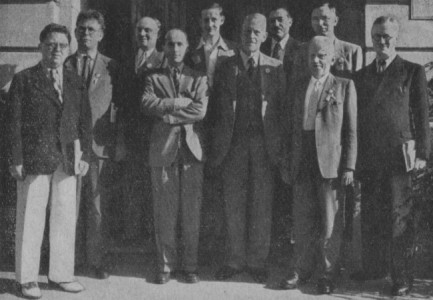
Left to right: K. Opočenský, H. Meyer, J. Louma, G.C. dal Verme, B.H. Wood, A. Rueb, M. Berman, E. Voellmy, M. Euwe, F. Peeters
Voellmy’s report on the following year’s Congress (The Hague, 30 July-2 August 1947) was published on pages 154-155 of the October 1947 Schweizerische Schachzeitung. He noted that at the proposal of the Soviet Union the issue of Spain’s membership was entrusted to the Central Committee, which was considered likely to annul the exclusion of Spain:
‘Cas de l’Espagne: Sur proposition de la Tchécoslovaquie, le Congrès de Winterthour avait exclu l’Espagne jusqu’à la prochaine assemblée (sous la forme d’une non-réadmission). Le Congrès de la Haye s’est occupé à nouveau de la question et, sur proposition des Russes, a remis la décision au comité central; il est assez probable que celui-ci cassera la sentence d’exclusion.’
The circumstances in which the Central Committee’s decision was eventually taken are not yet clear to us, but certainly Spain attended the FIDE Congress the following year (Saltsjöbaden, 11-15 August 1948), being one of the 23 countries listed on, for instance, page 181 of the November 1948 Schweizerische Schachzeitung.
The other issue is the Soviet Union’s role in the exclusion and eventual readmission of Spain. From page 63 of the December 1946 CHESS:
‘The USSR has not joined the International Chess Federation (FIDE). At the last FIDE Assembly Spain, who had been a founder-member and had paid its dues throughout, was ejected in the hope that the Soviets would join; the sacrifice has deeply wounded Spanish sentiment.’
On the other hand, page 272 of the September 1948 CHESS reported that the Soviet representatives objected to the presence of the Spanish delegate at that year’s FIDE Congress.
We hope that readers can assist us in building up further documentation on this matter.
(3821)
In C.N.s 879, 942 and 961 (see page 189 of Chess Explorations) readers discussed when FIDE began using Gens una sumus. The earliest instance found was surprisingly late (FIDE Revue, 1952), and no further information has yet come to our notice. Moreover, details are still lacking as to who decided, and when, that the Federation would adopt the Latin motto.
(4363)
Information is still required on when FIDE adopted the Latin motto Gens una sumus. As mentioned in C.N. 4364, the earliest occurrence in print known to us is surprisingly late: FIDE Revue, 1952.
Stephen Wright (Vancouver, Canada) now quotes a passage from page 184 of Russian Silhouettes by Genna Sosonko (Alkmaar, 2001):
‘The friends and chess colleagues of his [Levenfish’s] youth had been ... Pyotr Potyomkin, poet and chessplayer, who emigrated after the Revolution – a club named after him still exists in Paris, and it was to Potyomkin that the International Chess Federation was indebted for its slogan “Gens Una Sumus” ...’
Mr Wright notes that Potyomkin (or Potemkin) participated in the unofficial FIDE Olympiad in Paris in 1924 and that he died in 1926. What more is known about his claimed connection with Gens una sumus?
(5175)
Harrie Grondijs (Rijswijk, the Netherlands) reports that Gens una sumus was on the front cover of Alexander Rueb’s book De Schaakstudie, which appeared in ten parts as from 1949:
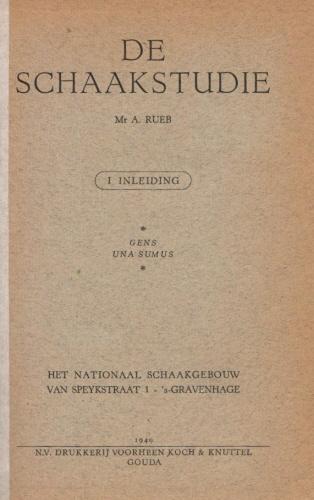
Our correspondent also informs us that he possesses a printed invitation from Rueb, dated Christmas 1945, to the first FIDE Congress of the post-War period. It states:
‘... no Chessfriend should forget, that we are One Nation ...’
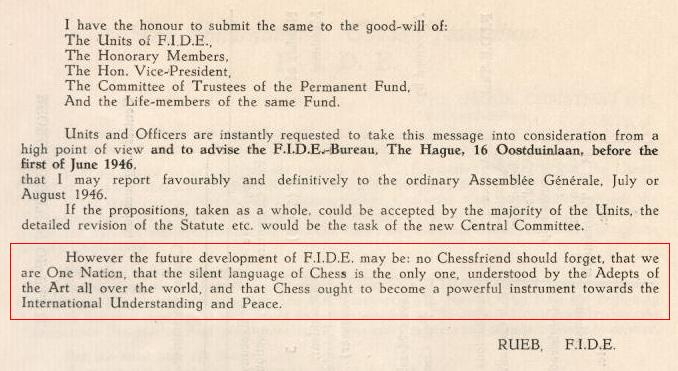
(5184)
See too C.N. 11067.
Leafing through the large bound volume entitled ‘FIDE Papers 1972-75’ (C.N. 10125), we noted the Statutes approved by the Federation on 25 June 1974:
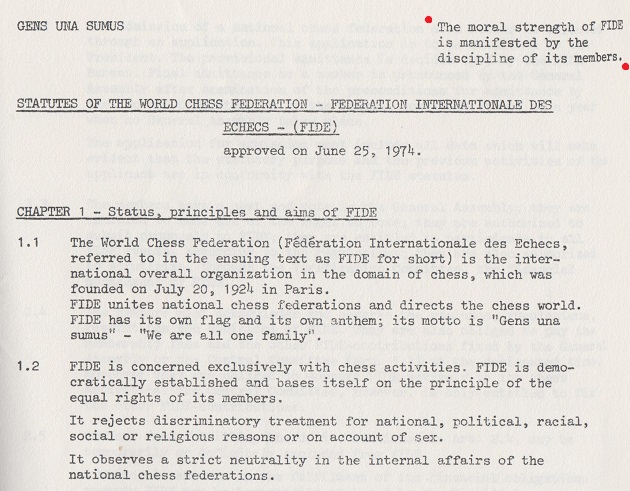
‘The moral strength of FIDE is manifested by the discipline of its members.’
It is unclear who conceived that promulgation, aspiration, exhortation or whichever other noun is most appropriate, but it remains at the top of FIDE’s Statutes even today.
(10126)
Updated link to that FIDE text (Statutes in effect until 1 March 2020).
Pages 254-255 of CHESS, August 1951 reproduced the score of the FIDE Anthem, with music by Count dal Verme (1908-1985) and words by Marcel Berman (1895-1960).
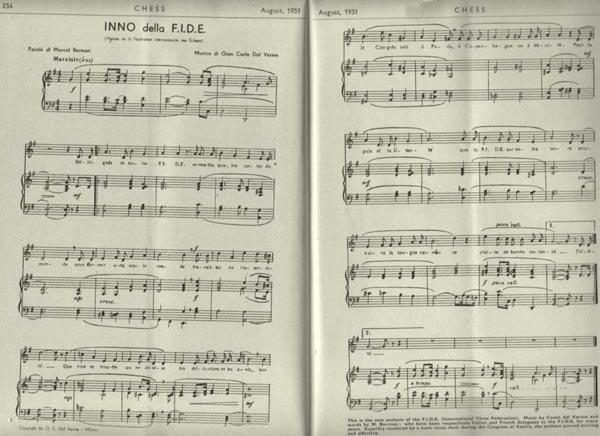
(3789)
When did FIDE first have a flag? (And why exactly? Does a flag serve any greater purpose than an anthem, emblem, logo or motto?)
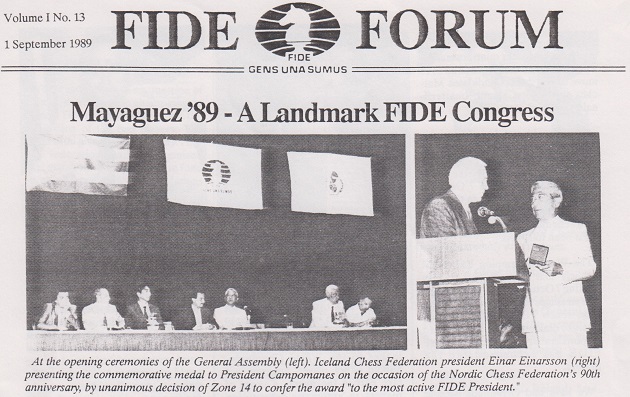
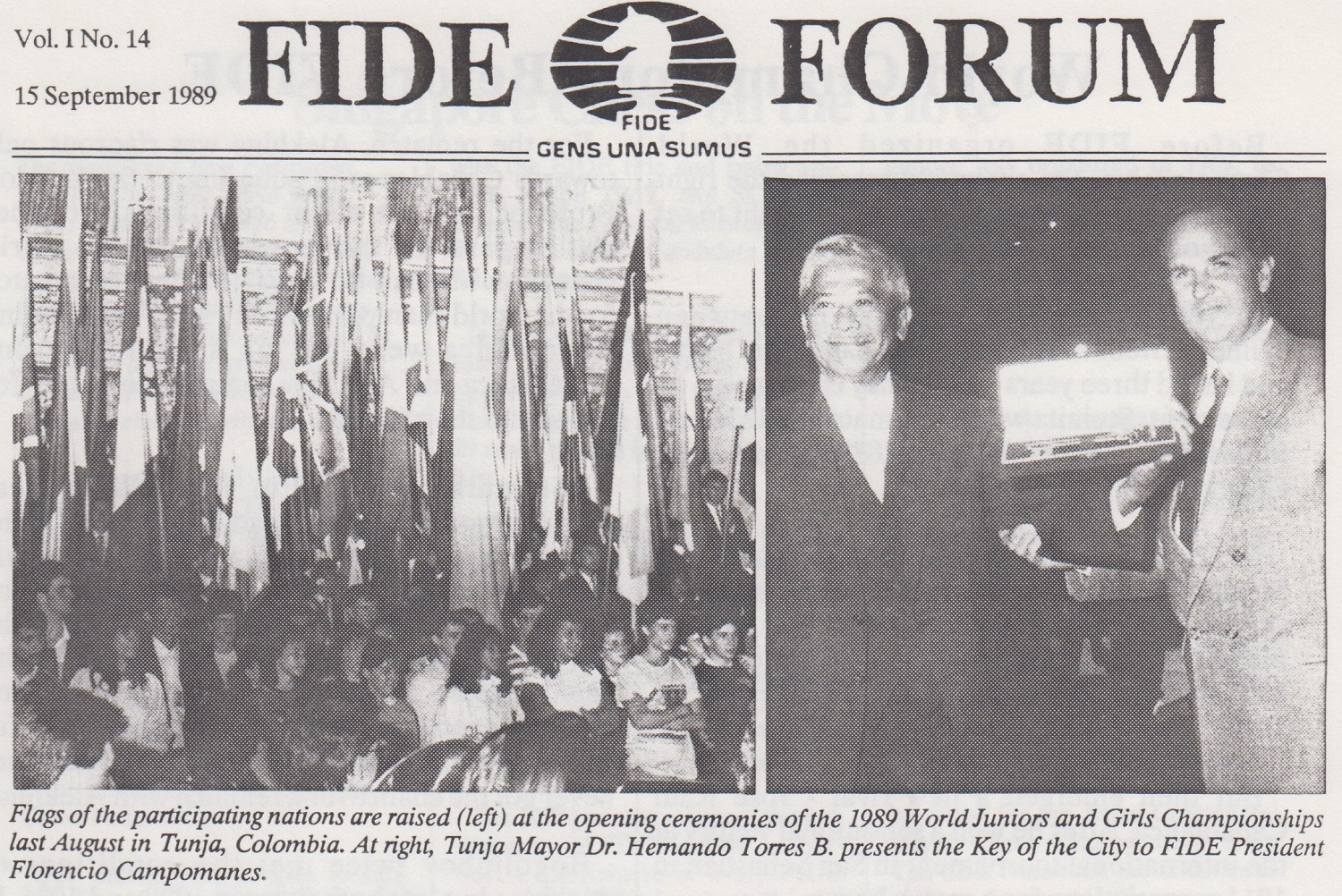
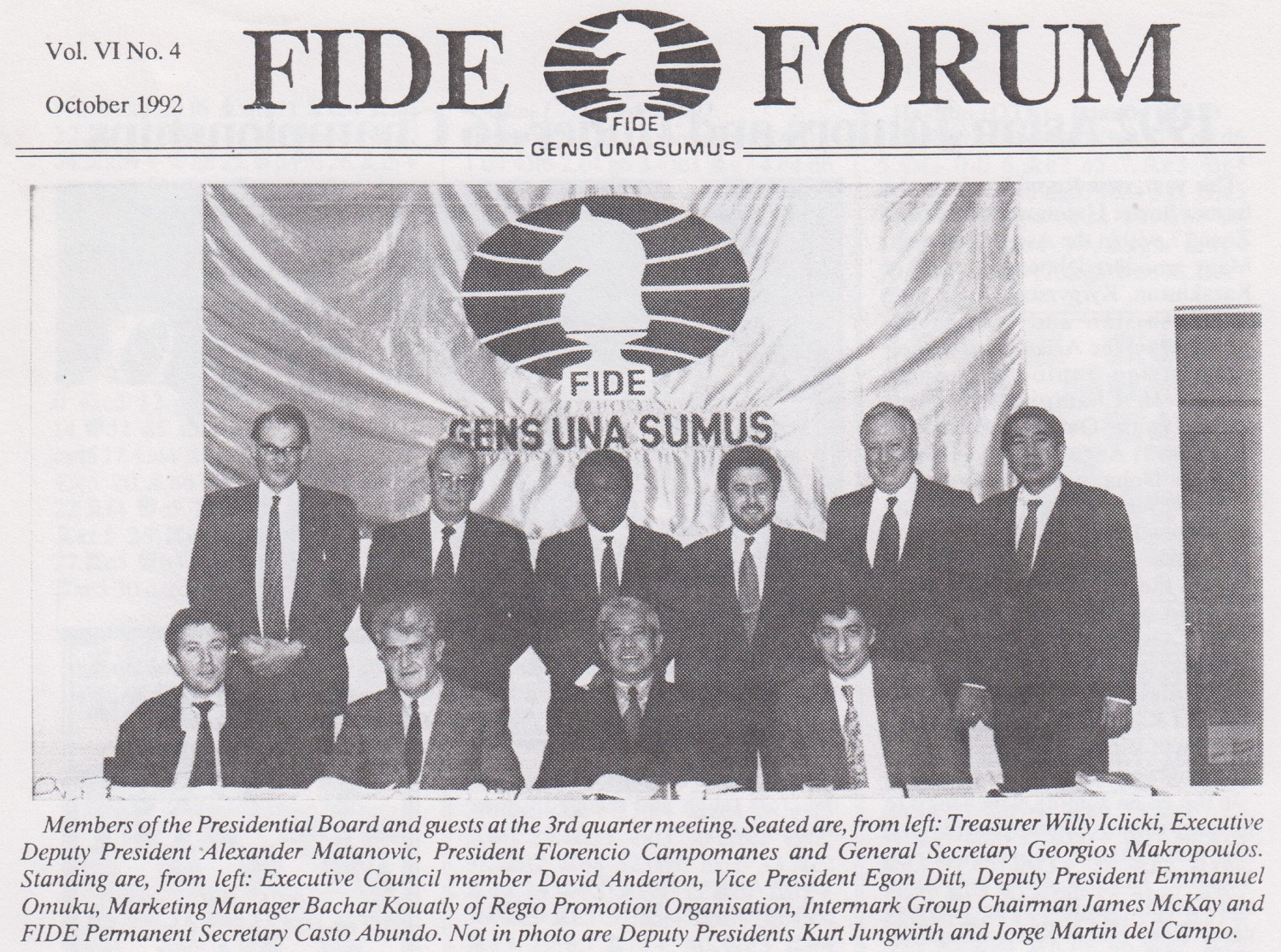
(11641)
Claus Montonen (Helsingfors, Finland) notes that a FIDE flag is in a photograph captioned ‘Participants of [sic] the Interzonal Tournament, Gothenburg, Sweden 1955’ in the 2009 edition of the Bronstein/Fürstenberg book The Sorcerer’s Apprentice, and that partial shots of what appears to be the same flag are in Tidskrift för Schack, 10-11/1952, page 254, and 4/1955, page 201.
As mentioned in C.N. 9711, the Swedish magazine can be read on-line.
(11652)
Who was the first world champion involved in the possible inclusion of chess in the Olympic Games? The episode, long since forgotten, is summarized below.
FIDE’s General Assembly in The Hague on 1 August 1928 received a report by the President, Alexander Rueb; the following passage was reproduced on page 8 of the Federation’s minutes and, by Erwin Voellmy, on pages 138-139 of the September 1928 Schweizerische Schachzeitung:
‘Au point de vue de la connexion (de la FIDE) avec les jeux olympiques, il n’est plus indispensable de suivre les lignes fondamentales tracées dans les règlements, car le Comité international olympique a déclaré à plusieurs reprises et très nettement qu’il refuse décidément de reconnaître le jeu d’échecs comme un sport olympique. Par son exemple, il enlève au jeu d’échecs toute possibilité d’obtenir une subvention gouvernementale justifiée et nie par là le caractère sportif d’un tournoi international comme celui que nous voyons aujourd’hui.
Le Comité a raison. On s’est déjà tellement écarté de la conception classique des jeux olympiques qu’on ne saurait s’attendre à un élargissement de ses vues. Le caractère artistique et religieux des jeux olympiques de l’antiquité est tout à fait abandonné. Au premier plan nous voyons la force musculaire et les démonstrations physiques qui attirent la grande masse et font sa joie. Pourquoi le Comité alourdirait-il sa tâche en accueillant un jeu artistique, le jeu d’échecs, qui ne rapporte rien et qui n’entraîne que des frais?
Pour autant que je sache, il n’y a qu’une seule unité, l’Association italienne, qui ait réussi à être comprise dans l’ensemble olympique national. Nous félicitons cordialement l’Italie et son Comité vigilant de ce résultat. Son importance réside en ceci, qu’en Italie du moins le développement et la prospérité d’un jeu intellectuel d’un rang si élevé pourra devenir un objet des soins constants du gouvernement.’
In short, Rueb noted that the International Olympic Committee had categorically refused to recognize chess as an Olympic sport, thereby denying chess the possibility of obtaining government subsidies. He added that the Olympic Games had lost their artistic character and that the Committee had no reason to burden itself with the costs that would result from embracing chess. Italy, Rueb believed, was the only FIDE member which had managed to join its national Olympic association.
See also A 1928 Chess Photograph (taken in The Hague).
At the following year’s General Assembly (Venice, 26-30 September 1929) FIDE decided that it would no longer recognize any distinction between amateurs and professionals as regards tournaments organized under its aegis or control, although member federations retained full freedom in the matter. In the case of the Olympic Games, the federation from the organizing country was at liberty to organize a chess tournament in accordance with the principles of the International Olympic Committee. And, at the proposal of Alekhine (France), a second paragraph specified that if the International Olympic Committee were to admit chess to the Olympic Games, FIDE would consider adjusting its regulations to the new situation.
And so it was that, with Alekhine’s involvement, FIDE’s regulations on organizing Olympiads were amended as follows:
‘Des Championnats dits Olympiques
La FIDE ne se chargeant pas de l’organisation des Tournois quadriennaux pour amateurs, à l’instar des Tournois de Paris 1924 et de La Haye 1928, recommande à l’Unité affiliée du pays organisateur des Jeux Olympiques d’assurer l’organisation de ces Tournois.
Au cas où le Comité Olympique International ferait entrer les échecs dans le cadre des Jeux Olympiques, la FIDE serait prête à remettre la disposition précédente en discussion, en vue de faire conformer son Règlement à ce nouvel état des choses.’
Sources of the above information: the minutes of the General Assembly in Venice, pages 8 and 14, as well as the report by Jean-Charles de Watteville on pages 185-187 of the Schweizerische Schachzeitung, December 1929.
Below is a woodcut of Rueb by Voellmy, from page 137 of the September 1928 Schweizerische Schachzeitung:
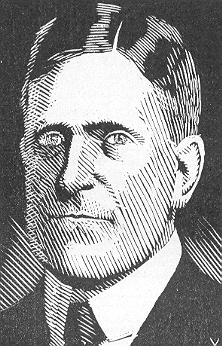
(3940)
This photograph of V. Smyslov, A. Rueb, M. Euwe and L. Szabó at the 1956 Candidates’ tournament in the Netherlands is taken from page 161 of the May 1956 issue of Ajedrez (Buenos Aires):
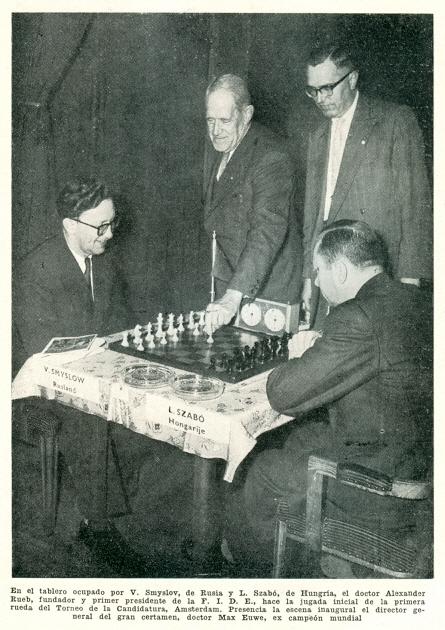
(5377)
‘One shudders to think what FIDE would have been without him.’ That was Harry Golombek’s verdict (BCM, December 1970, page 345) when Folke Rogard retired as President of the governing body and handed over to Max Euwe. Golombek also commented that the choice of successor ‘was unanimous and certainly no better man (or even as good) could be found to fill the place vacated by Folke Rogard after 21 years’ magnificent service in this post’.
Following the Swedish lawyer’s death in 1973, H.G. wrote an obituary in The Times which also appeared on pages 513-514 of the December 1973 BCM and, with some amendment, on page 277 of his Encyclopedia of Chess (1977). However, a detailed factual assessment of chess administration during the Rogard decades has yet to be written, and perhaps never will be. The task would be uncommonly difficult, and nowadays even Rogard’s name seems known to few.
(2725)
Some years ago (see pages 230-232 of Kings, Commoners and Knaves) we discussed chess connections involving Viveca Lindfors and Errol Flynn, who co-starred in the 1948 film Adventures of Don Juan. In passing we described Viveca Lindfors as ‘the only screen goddess lucky enough to marry a FIDE President’ (i.e. Folke Rogard). This 1946 photograph of the couple appeared in her autobiography Viveka ... Viveca (New York, 1981):
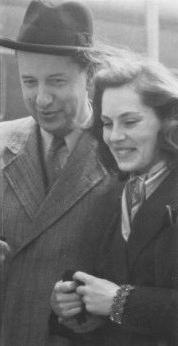
She was later married to the actor and writer George Tabori, and her book also has the following shot, ‘the first picture of the Tabori-Lindfors family in the house on 95th Street’:
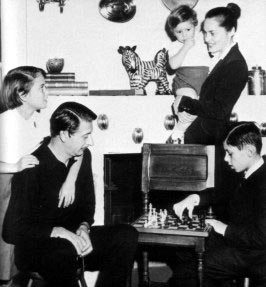
(3868)
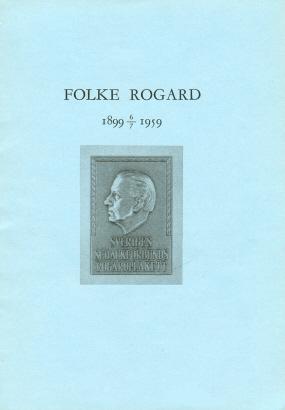
Calle Erlandsson (Lund, Sweden) has sent us a 20-page booklet, Till Folke Rogard på 60-Årsdagen (Örebro, 1959), which marked the then FIDE President’s 60th birthday. Pages 14-15 gave this game:
Folke Rogard – L. Bohmgren1 e4 Nf6 2 e5 Nd5 3 d4 d6 4 Nf3 c5 5 c4 Nb4 6 a3 Qa5 7 Bd2 Bf5 8 Nh4 Bg6 9 Nxg6 hxg6 10 exd6 exd6 11 Nc3 N4c6 12 d5 Nd4 13 Nb5 Qb6 14 Nxd4 cxd4 15 Bd3 Be7 16 O-O Nd7 17 b4 Kf8 18 f4 Bf6 19 Kh1 Re8 20 g4 a5 21 g5 Bd8 22 Qg4 Qc7 23 Rae1 Rxe1 24 Rxe1 Nb6 25 Qe2 Be7 26 Qe4 Qd7 27 Bf1 Nc8 28 Qxd4 Qg4 29 Qe3 f6
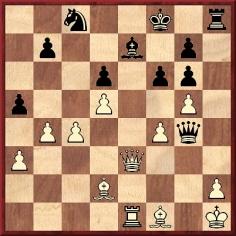
30 c5 Qd7 31 Bg2 axb4 32 c6 bxc6 33 dxc6 Qc7 34 axb4 and White won.
The booklet’s illustrations included, on page 6, a shot of Rogard playing lightning chess against Smyslov:
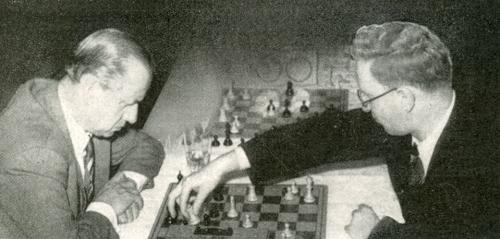
(5967)
Stephen Wright forwards this photograph which he possesses (FIDE Congress, Amsterdam, 1954):
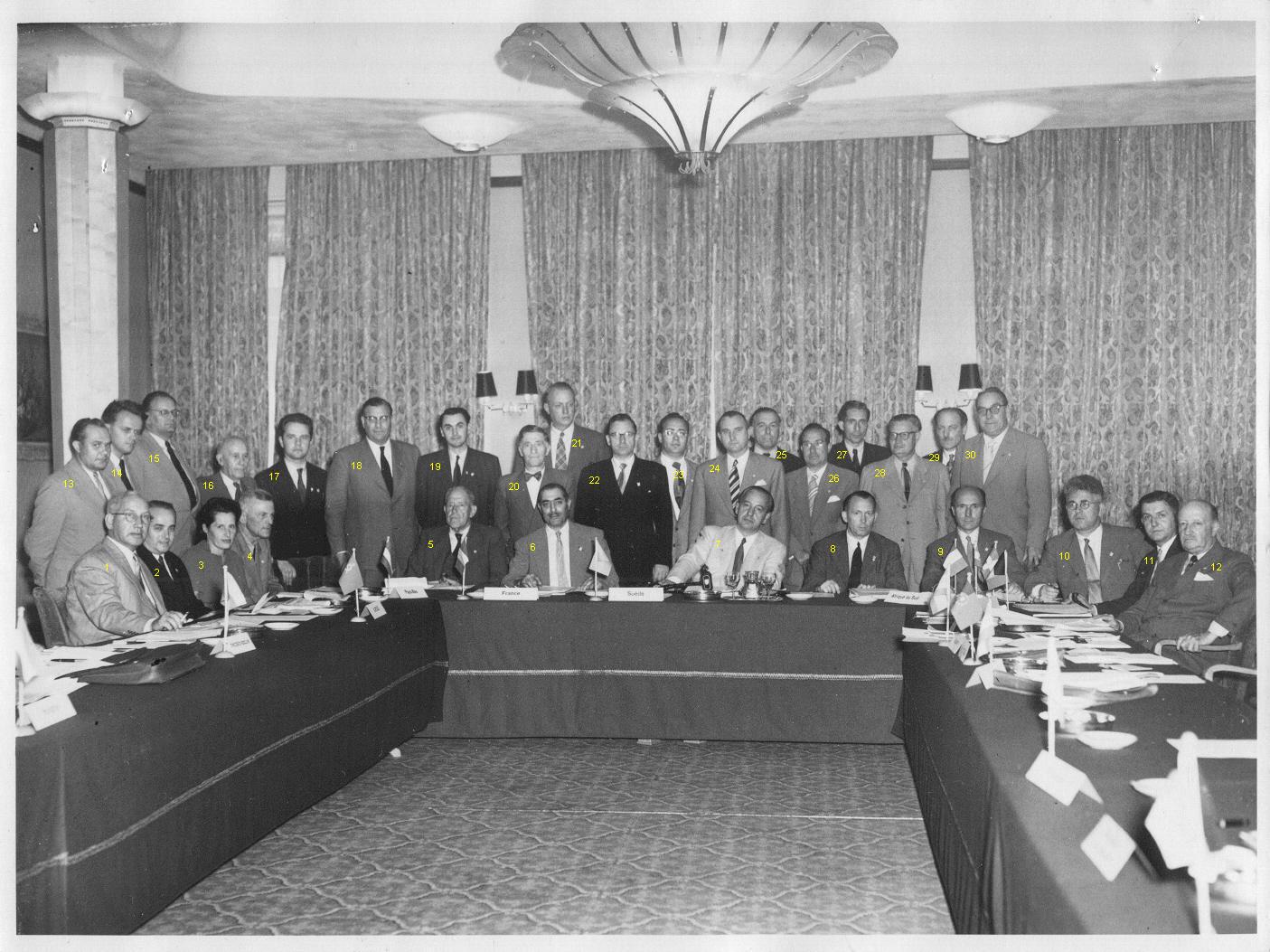
(8332)
1. Viacheslav Ragozin; 2. Salo Flohr; 3. Elizaveta Bikova; 4. A. de Bruyn; 5. Alexander Rueb; 6. Marcel Berman; 7. Folke Rogard; 8. Hugo Björk; 9. Gian Carlo dal Verme; 10. Hugo Meyer; 11. Jean Bricola; 12. Pierre Dierman; 13. Jaroslav Šajtar; 14. Ludĕk Pachman; 15. Maximilián Ujtelky; 16. Lajos Asztalos; 17. Enda Rohan; 18. John Prentice; 19. Wiget; 20. Jost; 21. Tuxen; 22. Wilfried Dorazil; 23. Nathan Divinsky; 24. Juan Carlos Laurens; 25. Harry Golombek; 26. Heras; 27. Werner; 28. Saltzl; 29. Hendrik Jan van Steenis; 30. Stock.
Acknowledgements for assistance with identification: John Donaldson (Berkeley, CA, USA), Alan McGowan (Waterloo, Canada), Dan Scoones (Port Coquitlam, Canada), Rick Wetzel (Cochranville, PA, USA) and Luc Winants (Boirs, Belgium). Mr McGowan pointed out that the photograph was published with a caption (surnames only) on page 112 of the 4/1954 FIDE Revue.
From page 273 of Chess Life, November 1963:
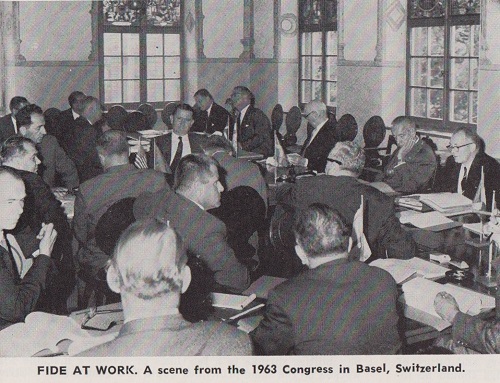
Dan Scoones has forwarded this photograph of the FIDE Congress in Wiesbaden, 1965 from page 40 of Schakend Nederland, November 1965:
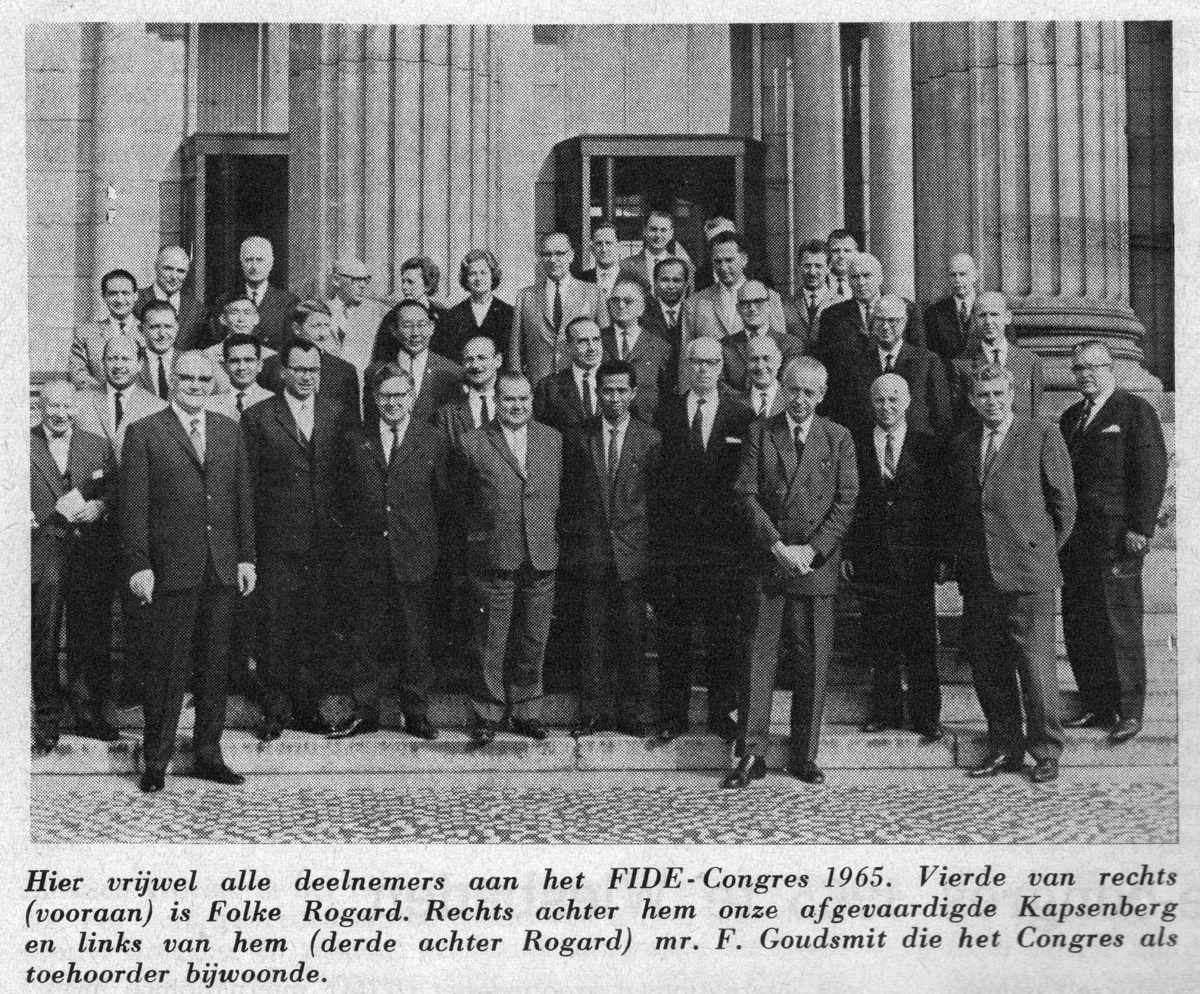
The photograph below comes from page 199 of the December 1968 Schweizerische Schachzeitung:
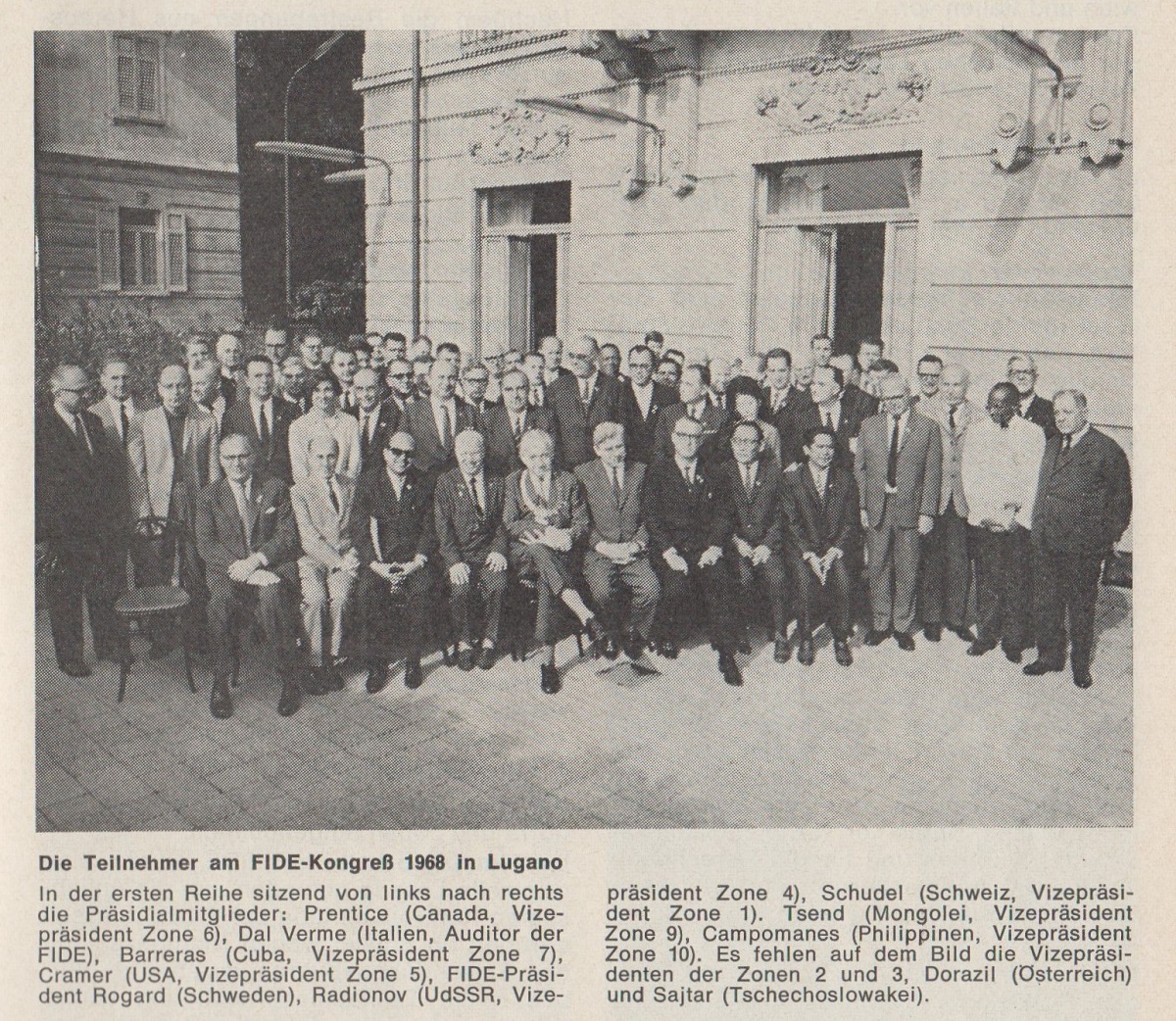
This photograph of Folke Rogard (C.N. 10898) was on the front cover of the February 1971 Chess Life & Review:
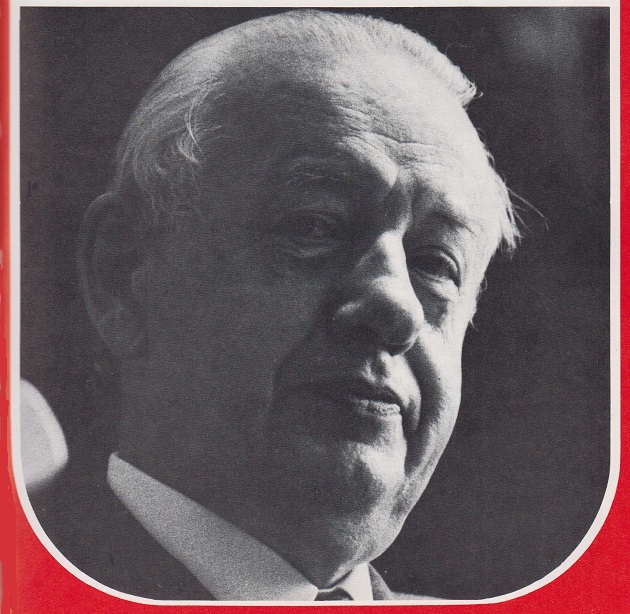
See too our Chessbase article on Rogard (2009).
From Henrik Malm Lindberg (Uppsala, Sweden):
‘I am writing a book on the second FIDE President, Folke Rogard, in his capacity as organizer of modern chess during the Cold War period. His presidency ran from 1949 to 1970 and was replete with events which can and should be seen in the light of the battle between East and West.
A particular question concerns the Ukrainian/Soviet master, Fedor Bohatirchuk, who was later a Canadian champion. He settled in Canada in 1949 and then fought to receive a GM, or at least an IM, title from FIDE for his accomplishments during, in particular, the 1930s. The matter was settled at the 1954 FIDE Congress, when he received the IM title. Twice it had been discussed by the FIDE Qualifications Commission, but the Soviets (Ragozin) had objected. Prior to 1954, Rogard was criticized by Canadians (especially Bernard Freedman), and it appears that agreement was reached in 1954 after a Soviet visit (Kotov and Bondarevsky) to Canada.
From the FIDE archives in Leeuwarden I have a letter dated 6 August 1954 from Freedman to Rogard which reported on an agreement for Bohatirchuk to be an IM “by Right and by Strength”. Are any other sources known which either confirm or contradict this account?’
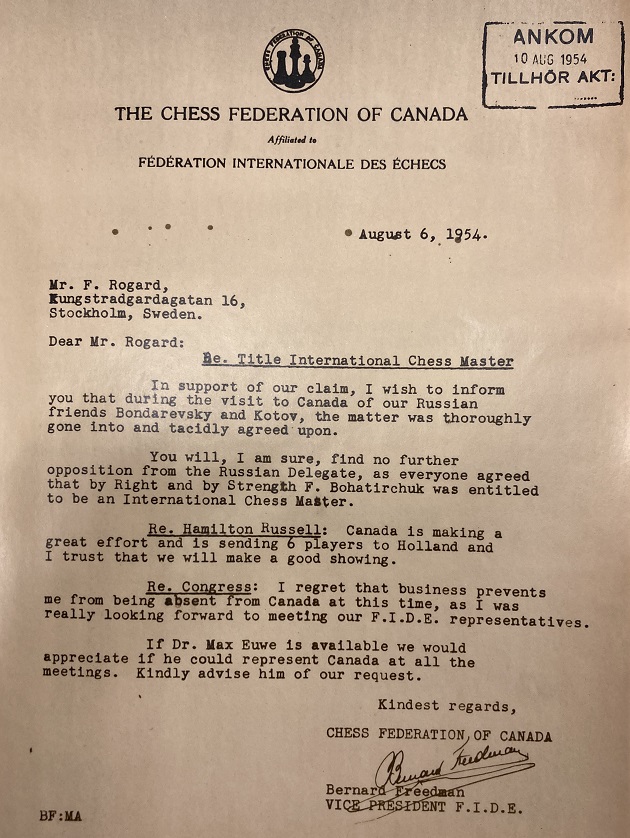
(11955)
We wonder what became of the FIDE project reported on page 648 of the December 1980 BCM:
‘The International Chess Federation has decided to award gold medals as follows: “Alekhine Medal” for the best attack; “Capablanca Medal” for the best endgame; “Lasker Medal” for the best defence, and “Steinitz Medal” for the best strategical plan. A commission, composed of Dr M. Euwe (Chairman), GM G. Barzca, GM A. Kotov, GM A. Matanović, GM M. Najdorf and GM L. Schmid, will select the players that will be awarded the prizes annually at the FIDE Congresses. For the first award, in 1981, games played in 1980 must be sent to the FIDE Secretariat by 1 March 1981, with short commentaries ...’
See too Chess Awards.
See The Termination.
See FIDE Presidential Campaigns, The 1986 FIDE Presidential Election, Ricardo Calvo: Persona non Grata and Comic Relief: Raymond Keene and Chess Politics.
Alan McGowan (Waterloo, Canada) has forwarded a number of photographs:
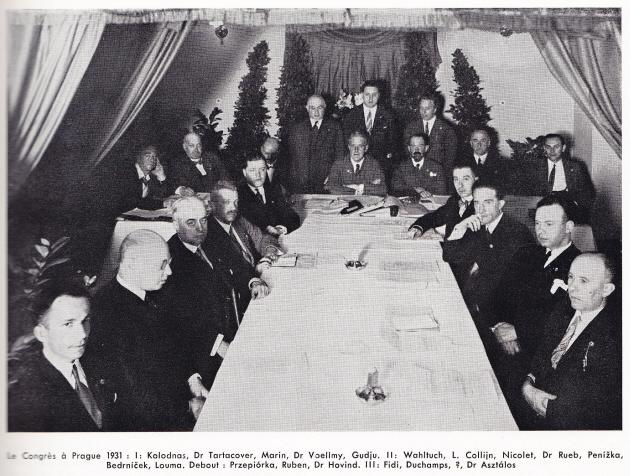
Source: FIDE Revue, 1/1955, page 3.
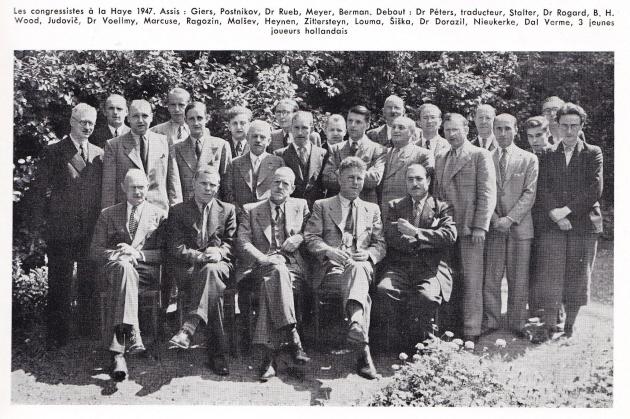
Source: FIDE Revue, 1/1955, page 5.
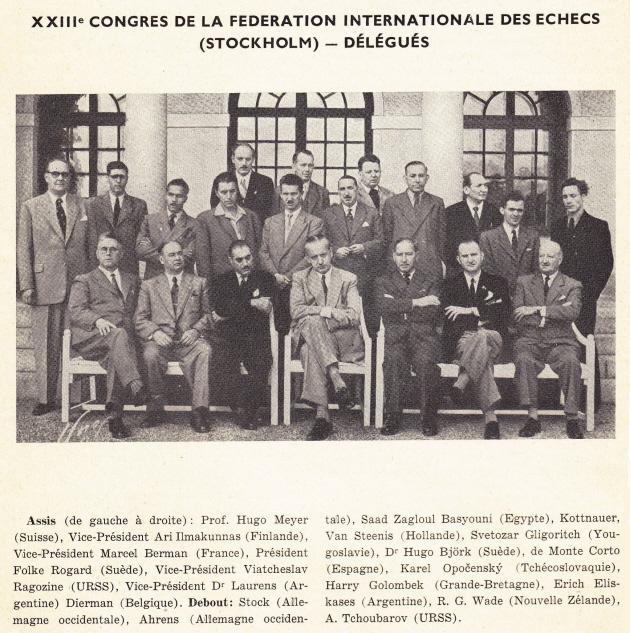
Source: FIDE Revue, 1953, page 4 (1952 Congress).
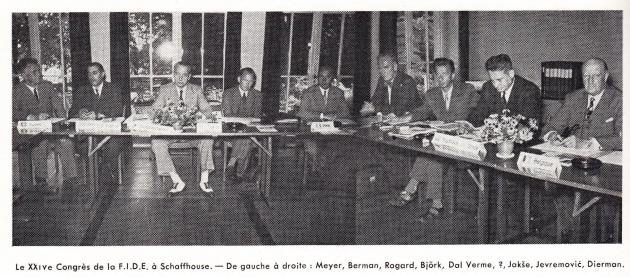
Source: FIDE Revue, 1/1954, page 2.
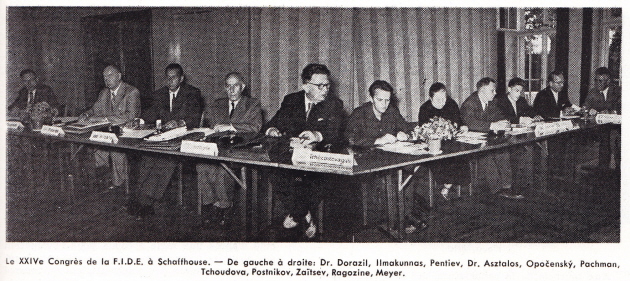
Source: FIDE Revue, 1/1954, page 5.
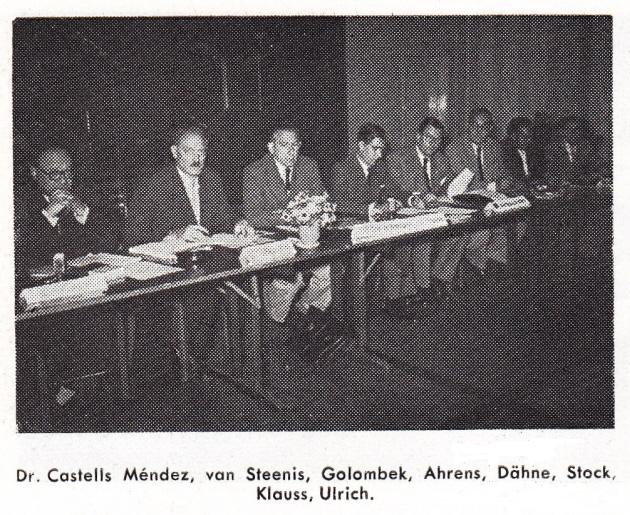
Source: FIDE Revue, 1/1954, page 6 (1953 Congress in
Schaffhausen).
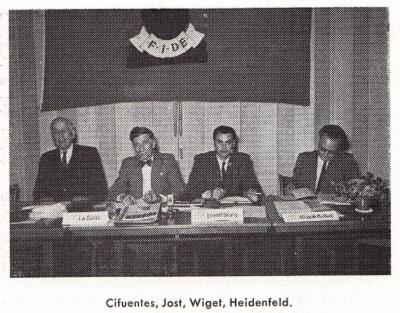
Source: FIDE Revue, 1/1954, page 7 (1953 Congress in Schaffhausen).
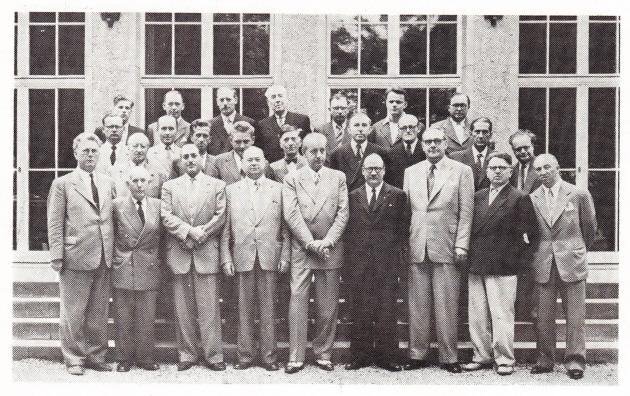
Source: FIDE Revue, 1/1954, page 10 (1953 Congress in Schaffhausen – no caption given).
The photograph below is from page 5 of CHESS, October 1953:
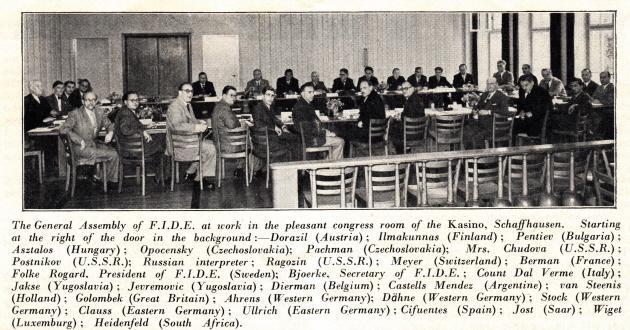
(8786)
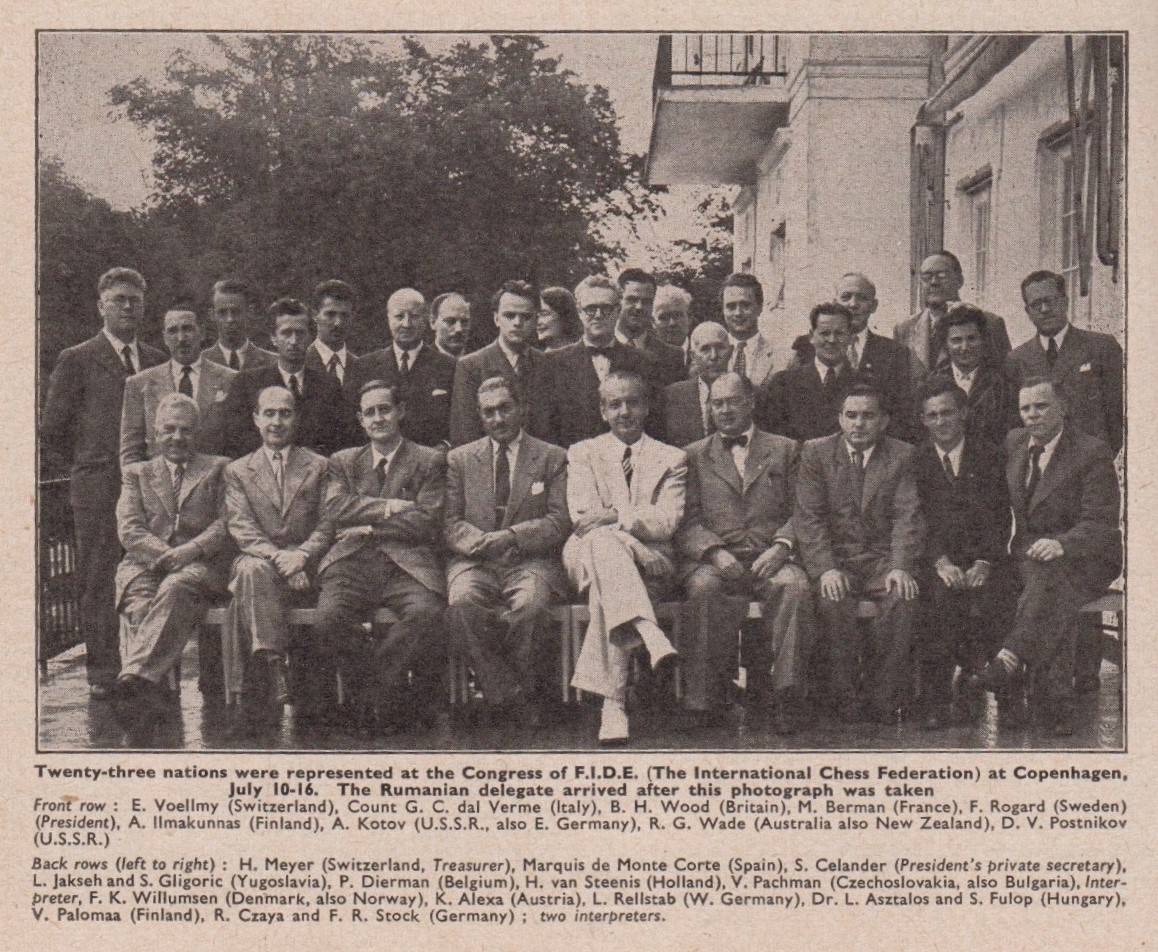
Source: CHESS, August 1950, page 208.
The April [1984] BCM (pages 137-138) reports that FIDE is out to improve the sartorial standards of chessplayers, especially English ones. The notion of official intervention is not pleasing, yet it is a fact that many a British master would look more elegant if enwrapped in a horse-blanket or barrage-balloon. And their written English is no better than FIDE’s.
(701)
The report on FIDE’s 8th Congress (Prague, 22-26 July 1931) indicates that on behalf of the Polish Federation Dawid Przepiórka asked FIDE to draw up a list of International Masters and establish the conditions for the granting of such titles. The President, Dr Rueb, was unenthusiastic, but to study the question a small Committee was formed, with Alekhine, Vidmar, and Przepiórka among the members. It was not until the 12th Congress (Warsaw, 28-31 August 1935) that a text was adopted. This stated that the title of International Master would be awarded by FIDE to any player who won a tournament featuring a minimum of 14 players if at least 70% of the players were International Masters, or who came second twice in such events. Less successful tournament scorers could obtain the title if they also won a recognized match (of at least four games up) against an International Master. Initially, the Committee was to prepare a basic list of recipients. Titles would be awarded for life, and there could be no appeal against the Committee’s decisions.
When a (modified) system was eventually introduced (20th Congress, Paris, 20-22 July 1949), a distinction was made between Grandmaster and International Master. There were under 30 of the former, and fewer than 100 of the latter.
Most of these title-holders were familiar personalities whose names needed no adornment, but nowadays ‘Grandmaster’, ‘International Master’, etc. are used almost like forenames. Paradoxically, the very top players outgrow their titles; it would be incongruous, and perhaps even insulting, to refer to ‘Grandmaster Fischer’.
(1982)
From the March 1944, BCM, page 49:
‘One of our supporters has written to us in protest against our reporting chess news from countries with which we are at war; according to him, we should ignore them and not give them gratuitous publicity.
… We have given chess news from Germany in an entirely objective spirit, except when we criticized, perhaps unnecessarily, propagandist attempts to institute a “new order” in chess also by the creation of a new International Chess Association, which apparently intended the permanent exclusion of such unimportant agglomerations as the USA, Russia and the British Empire. We need not have wasted criticism on such a ludicrous, megalomaniac fatuity, of which very little is heard nowadays.’
(Kingpin, 2000)
See Chess: Hitler and Nazi Germany.
A photograph from our collection, shown in C.N. 10190:
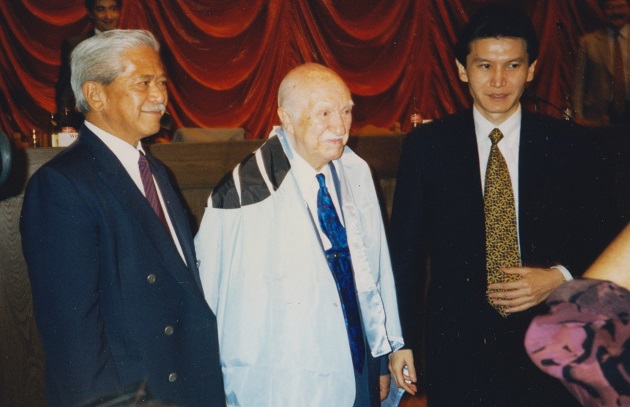
Florencio Campomanes, Miguel Najdorf, Kirsan Ilyumzhinov (Yerevan, 1996)
Harry Golombek was in characteristic form in his Times column, Review section, page 9, 6 May 1972:

The work referred to by Golombek was undertaken in the early 1950s. On pages 278-279 of the October 1952 BCM he wrote:
‘For some years now the FIDE has been making attempts to revise the old rules and produce a new version that will avoid the ambiguities, omissions and falsities that abounded in the former set of rules of chess. The matter proved too complex to be dealt with at last year’s congress at Venice, when the sub-committee for the task produced differing drafts exceeding in number the actual composition of the committee.
This time a sub-committee was appointed to consider a new version (members being the President of FIDE, Folke Rogard, and Messrs Berman, Golombek and Wade). After some arduous and concentrated work this committee was able to agree on a final version that was subsequently approved by the General Assembly ...’
The text was finally passed by FIDE’s Congress in Schaffhausen the following year. Source: page 273 of the British Chess Federation’s Year Book 1953-1954 (Leeds, 1953). Pages 273-293 gave the full text.
Further to C.N. 10198, below is an extract from the section regarding castling, on page 277:
‘Castling is a move of the king and a rook, reckoned as a single move (of the king), which must be carried out in the following manner: The king is transferred from its original square to either one of the nearest squares of the same colour in the same rank; then that rook towards which the king has been moved is transferred over the king to the square which the king has just crossed.’
Page 279 stated that ‘a move is completed ...’
‘... In the case of castling, when the player’s hand has quitted the rook on the square crossed by the king; when the player’s hand has quitted the king the move is still not yet completed, but the player no longer has the right to make any other move except castling.’
(10218)
On the subject of Harry Golombek and FIDE meetings, we recall the concluding paragraph of his report on the FIDE Congress in Sofia (September 1961) on pages 48-51 of the British Chess Federation’s Year Book 1961-1962 (Warrington, 1961):
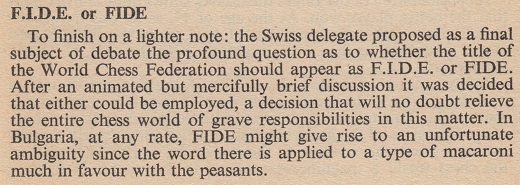
A brief Internet search shows an entity which produces noodles. The Bulgarian products include this one:
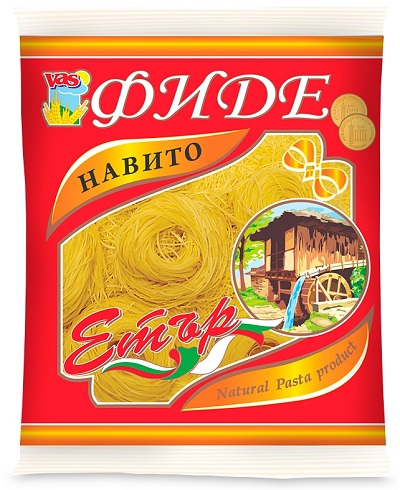
(10219)
An unfathomable claim about FIDE on pages 288-289 of Who Was The Strongest? by Raymond Keene, Nathan Divinsky and Jeff Sonas (Aylesbeare, 2006):
‘Three years later [in 1993] Kasparov annihilated Nigel Short in a match that was held outside the auspices of FIDE, the World Chess Federation, which had shown itself increasingly incompetent to handle events at the highest level. FIDE soldiered gamely on with its own championship, much as it did before the death of Alekhine in 1946, but FIDE always had to make do without the world’s top two players at any given time.’
(11167)
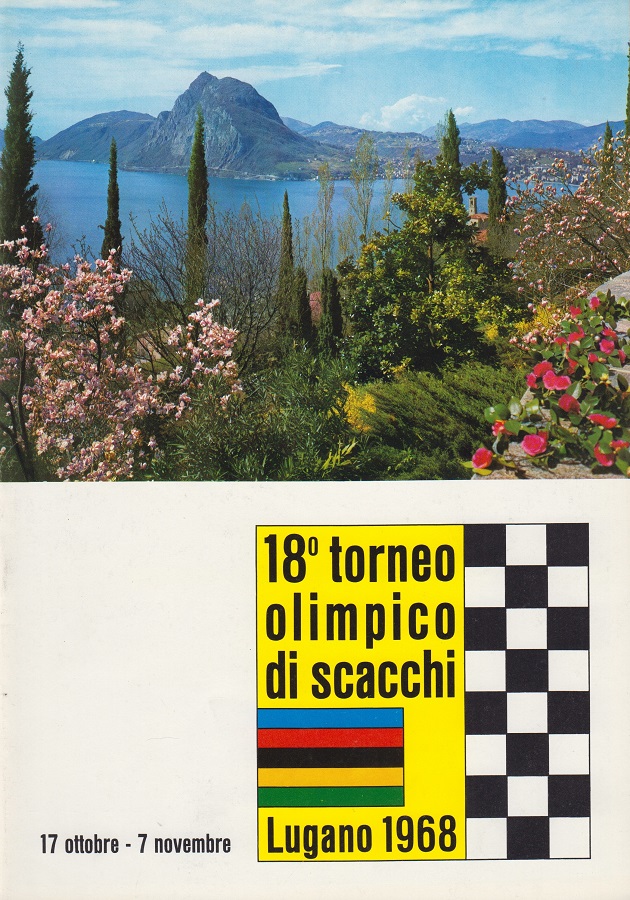
The 28-page programme had a message from the FIDE President, Folke Rogard:
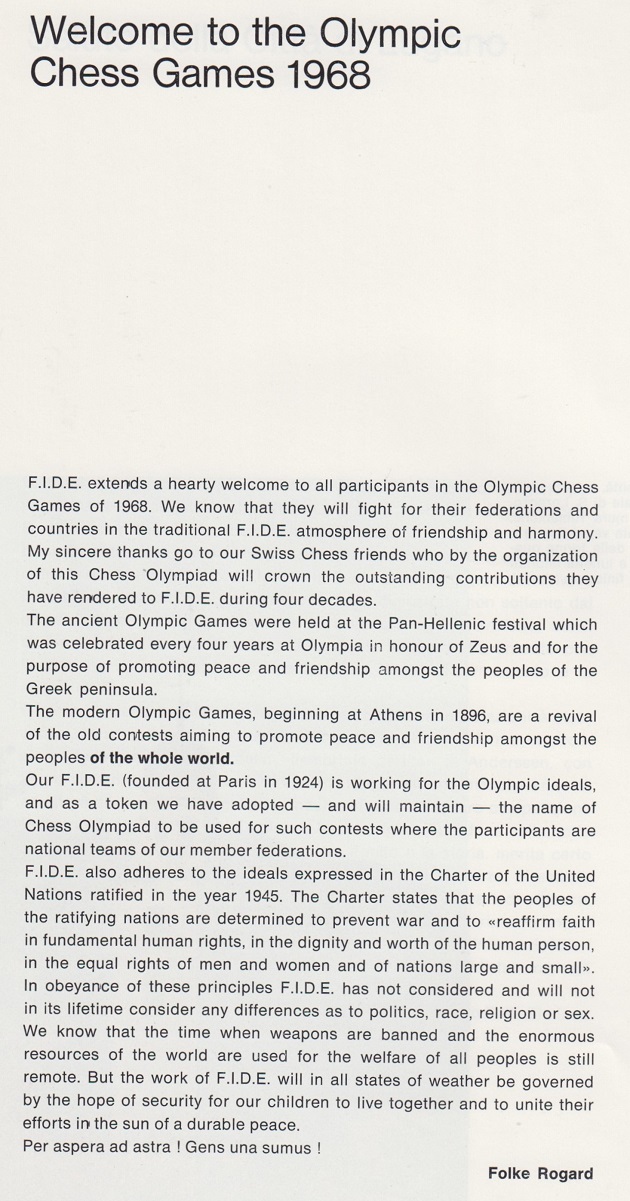
(11233)
Two photographs taken at the Club Argentino de Ajedrez which have been sent to us by Carlos León Cranbourne (Buenos Aires):
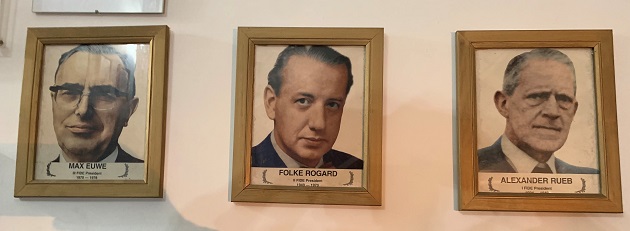
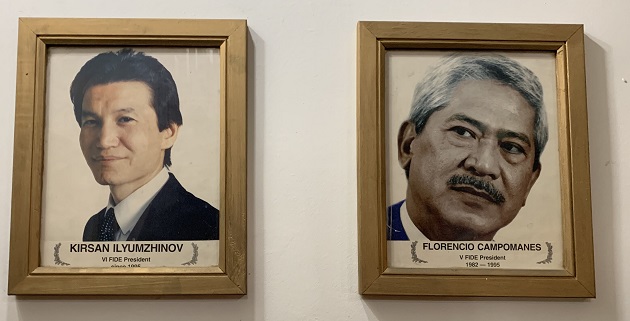
(11341)
From his archives Jan Kalendovský (Brno, Czech Republic) sends three diplomas awarded to Ilja Mikan:
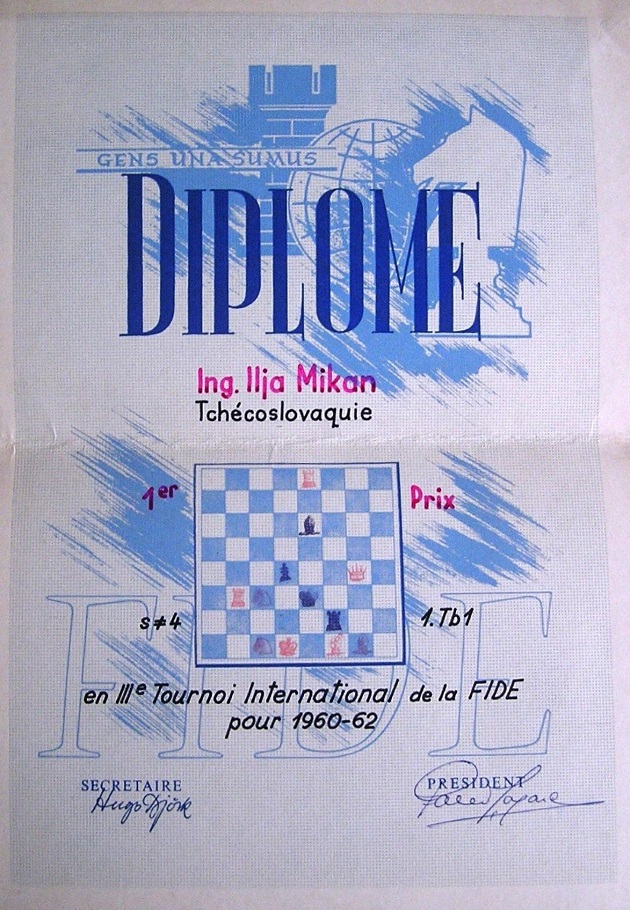
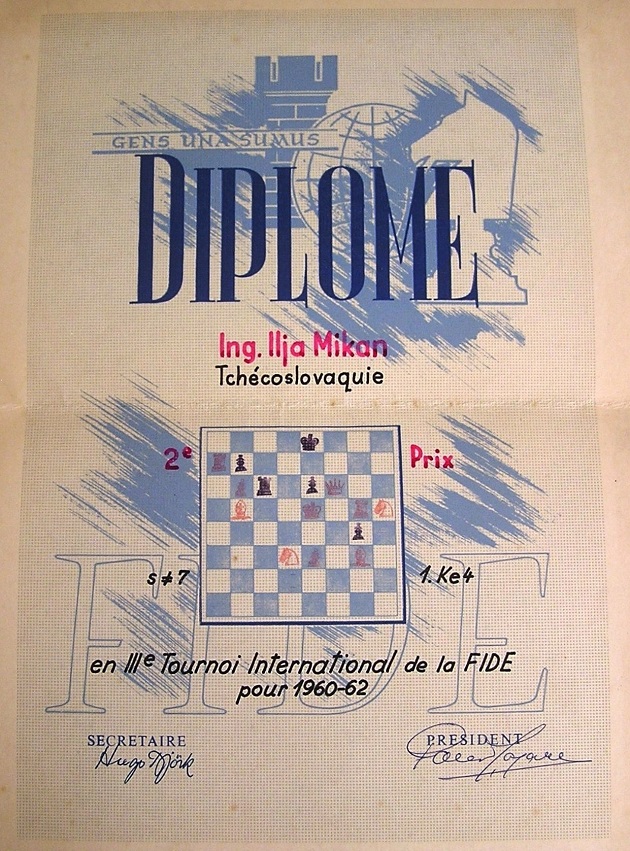
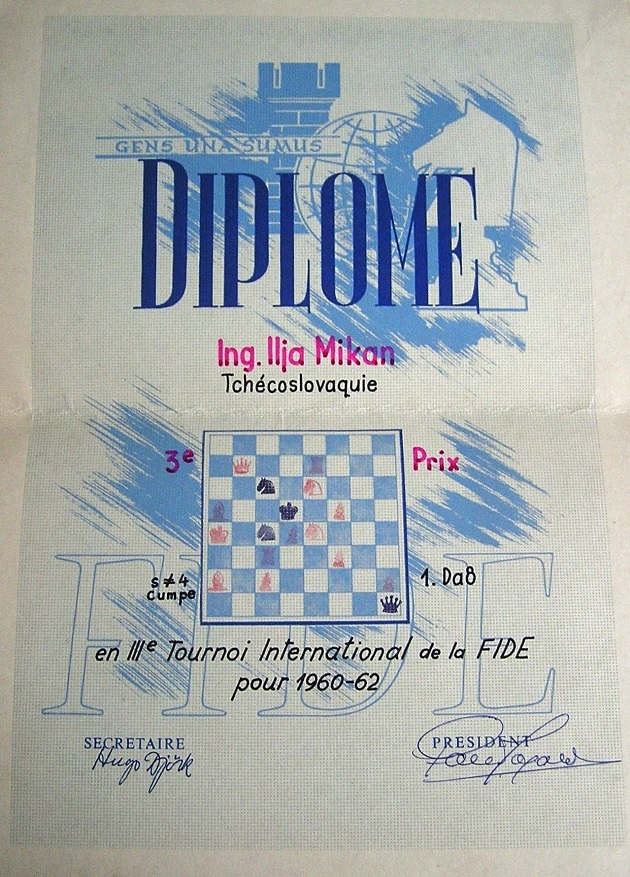
(11715)
There follows an interview by Giam Choo Kwee with Lim Kok Ann which the latter sent us in September 1986:
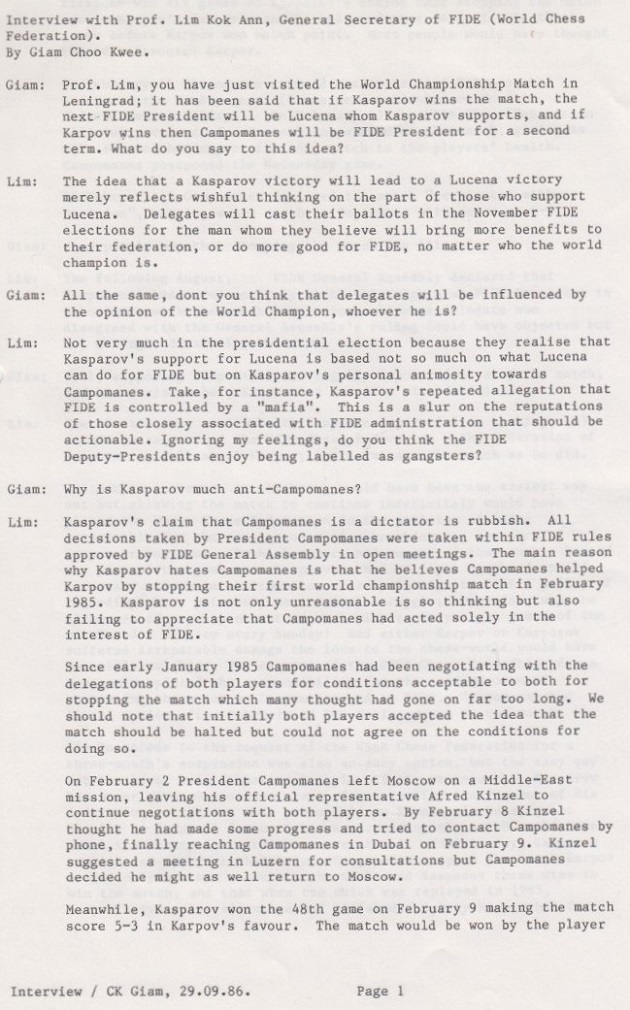
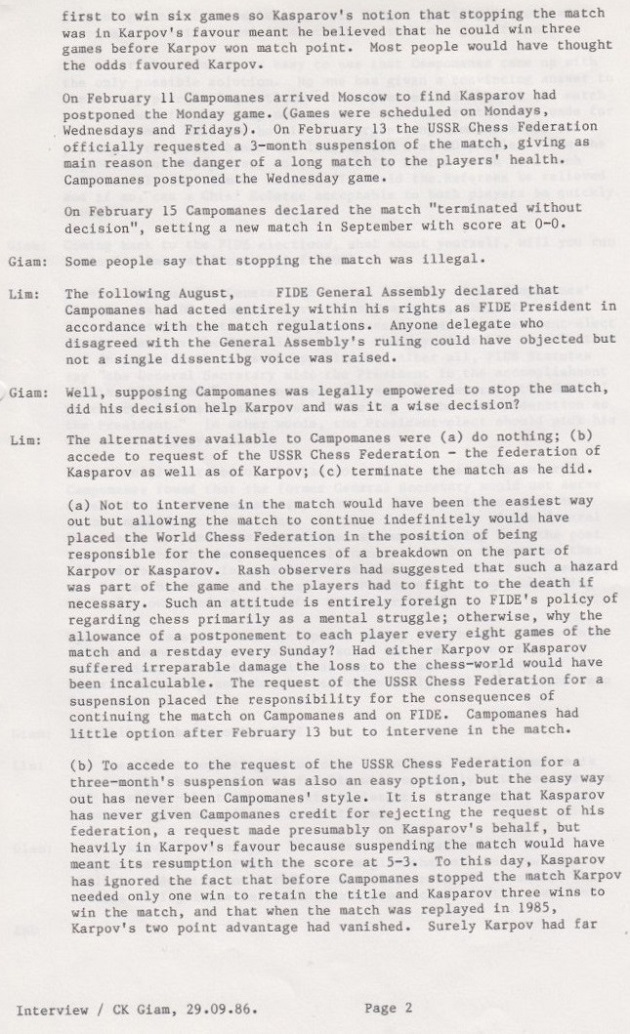
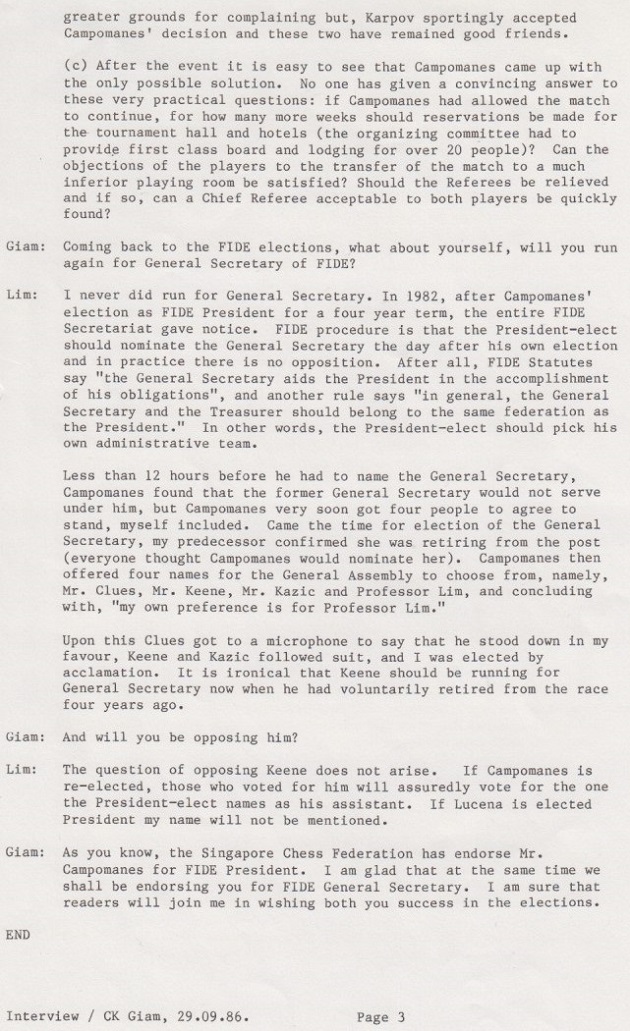
This 1968 photograph of Giam Choo Kwee and Lim Kok Ann comes from the private archives of Choong Liong On and is reproduced courtesy of Olimpiu G. Urcan (Singapore):
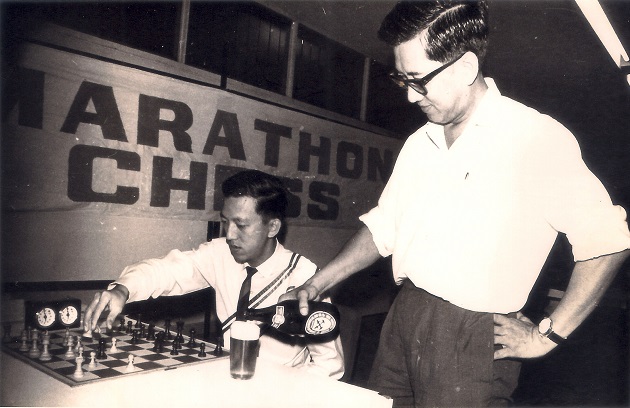
Regarding the picture, see too page 99 of the book Singapore Chess (C.N. 10567).
(11817)
Below are the key parts of a letter to us dated 1 January 1986 from the General Secretary of FIDE, Dr Lim Kok Ann:
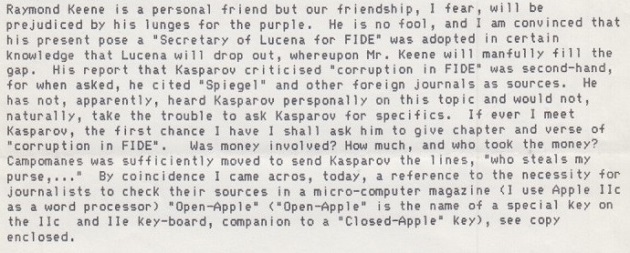


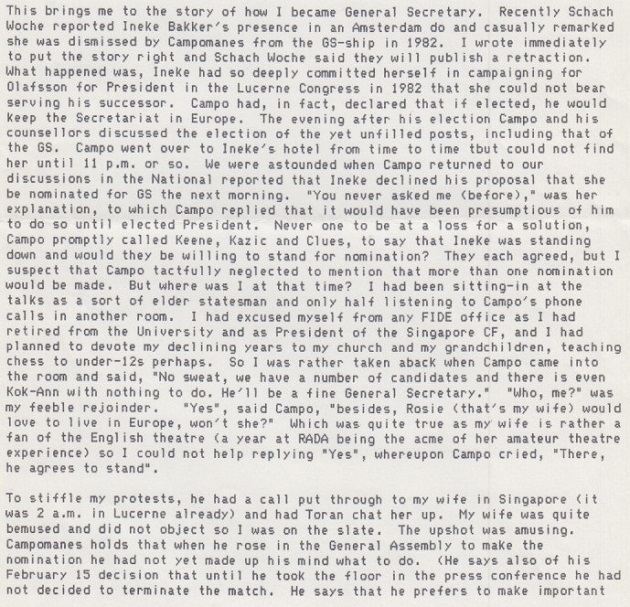
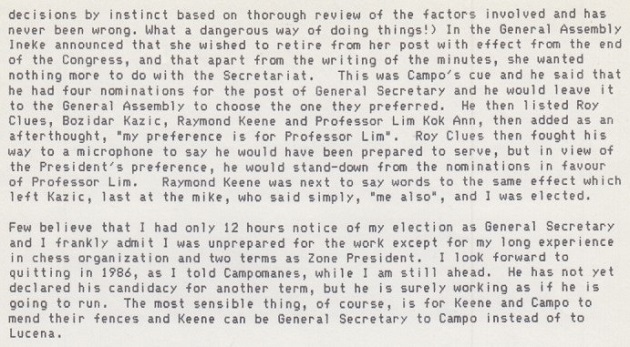
We also reproduce here another letter from Lim Kok Ann, dated 13 January 1986:
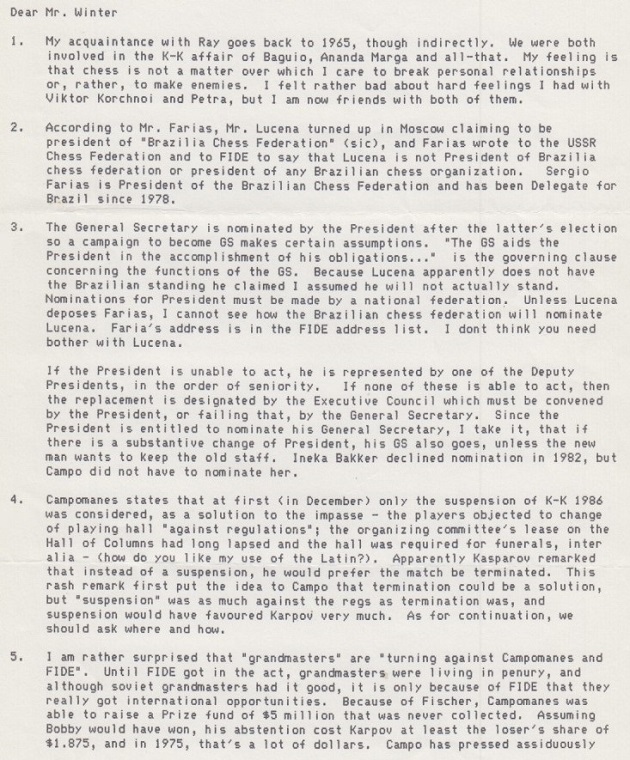
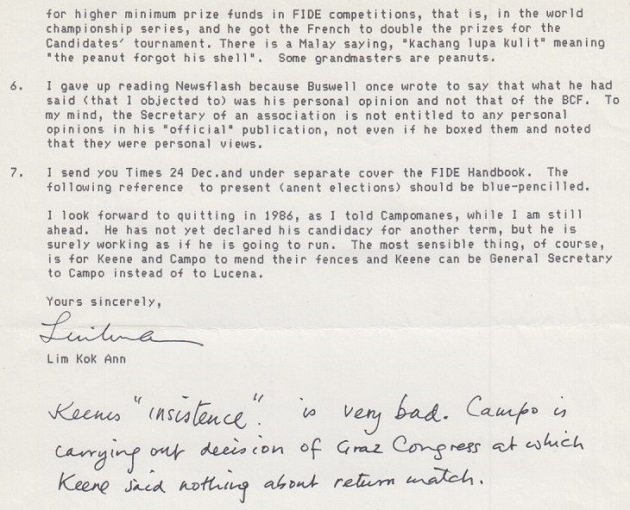
(11856)
Below is the FIDE President’s Circular Letter No. 3 1985/86, dated 25 February 1986. It includes an extensive ‘Review of Press Reports’ by Lim Kok Ann, the Federation’s General Secretary:
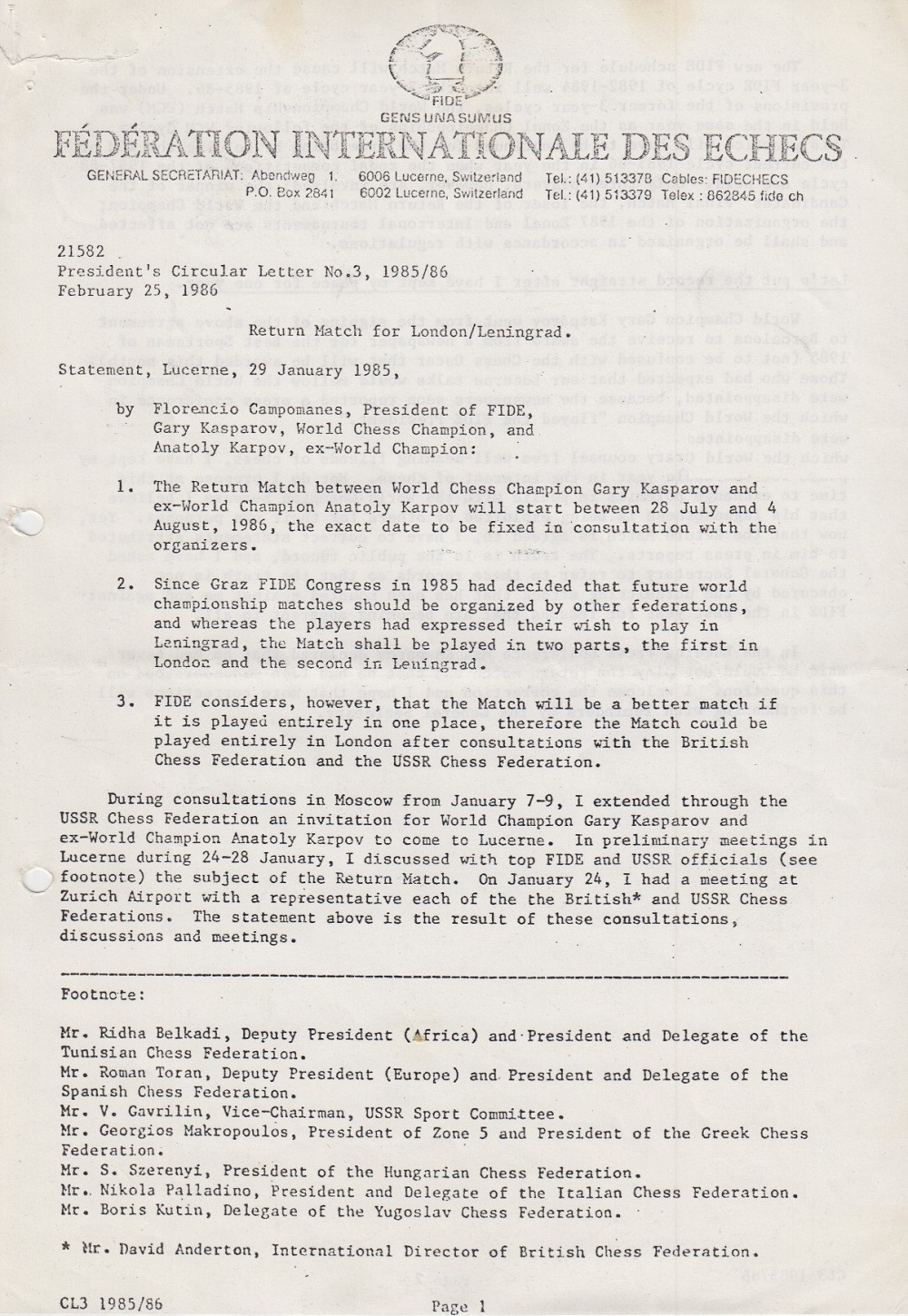
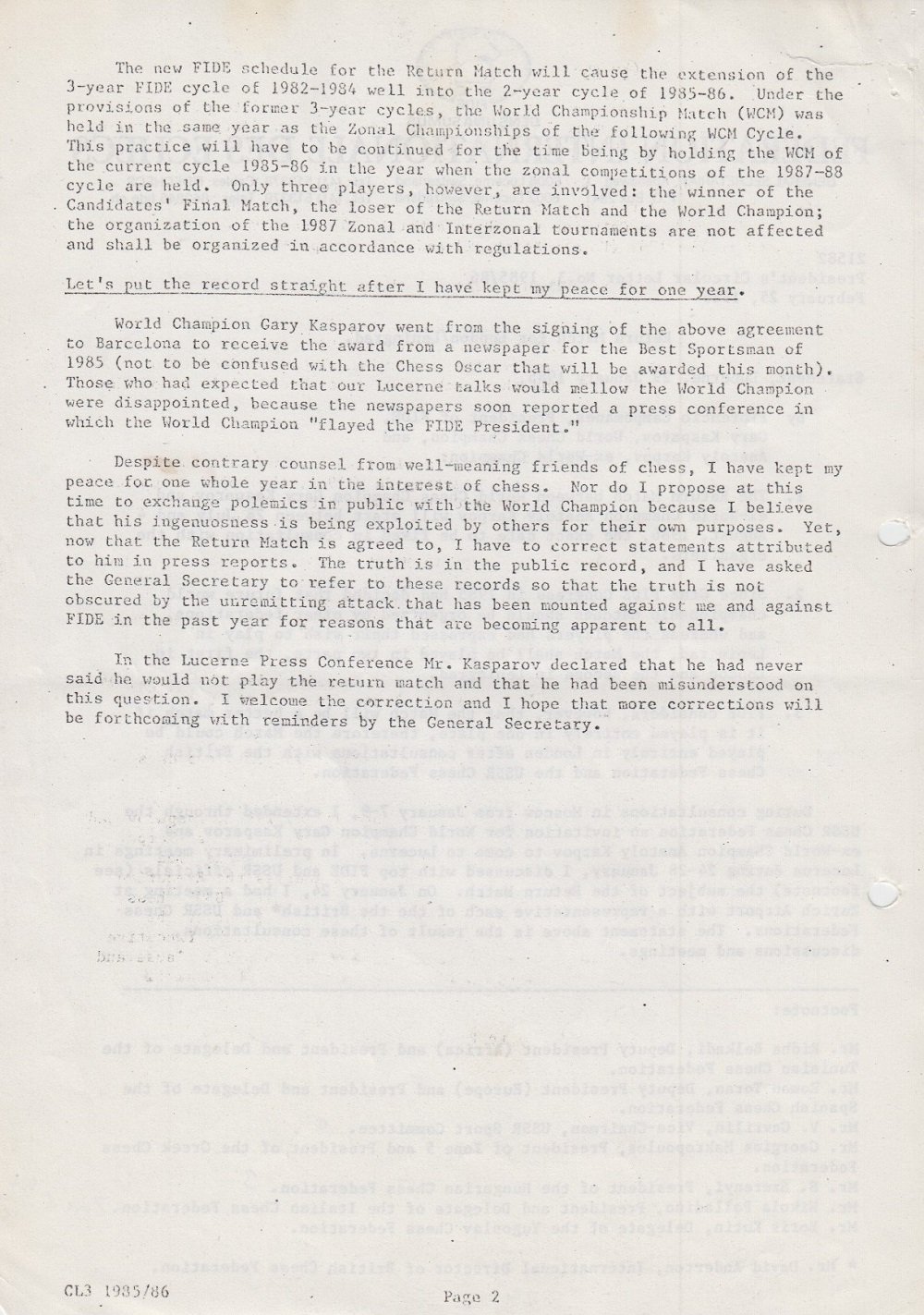
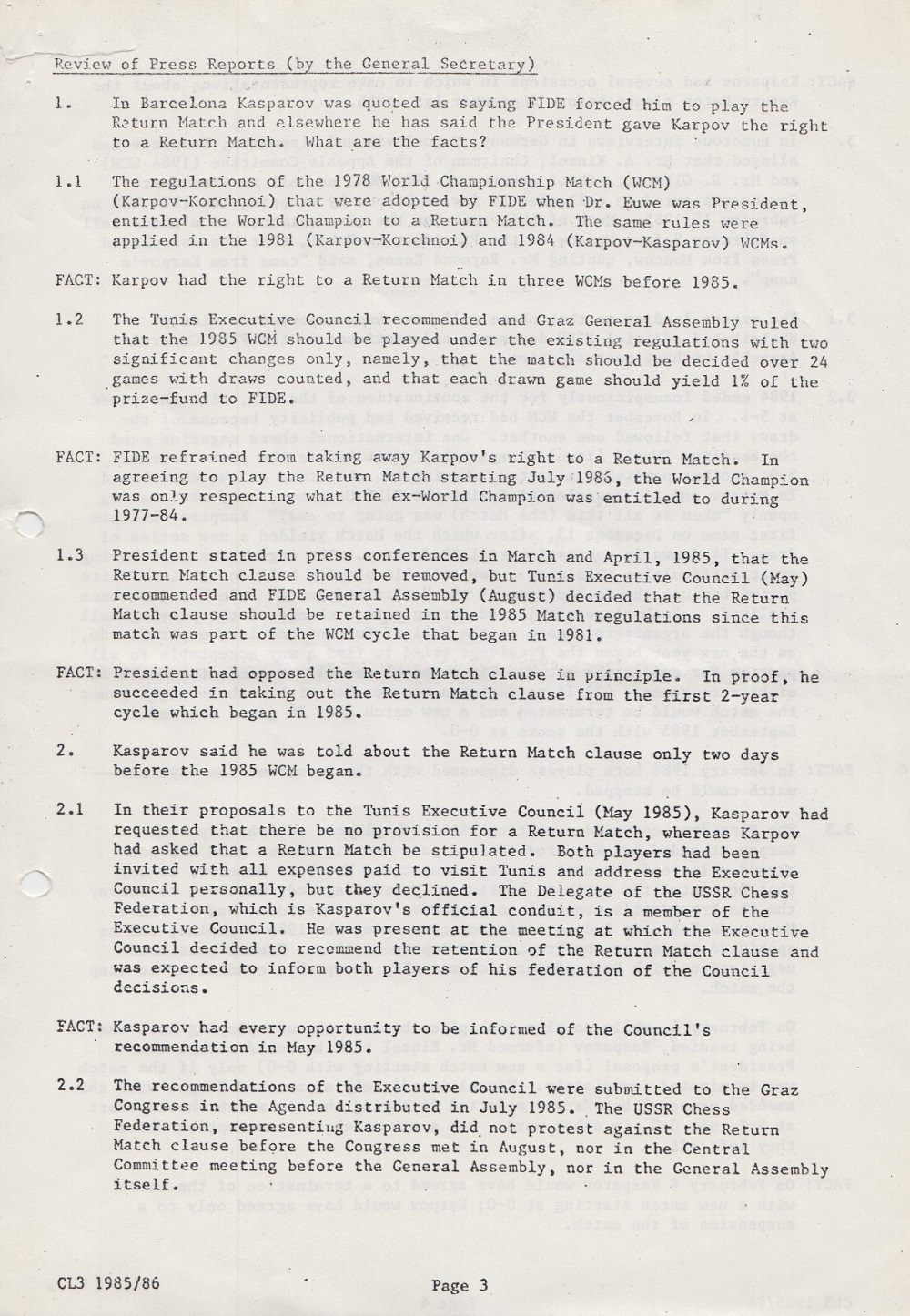
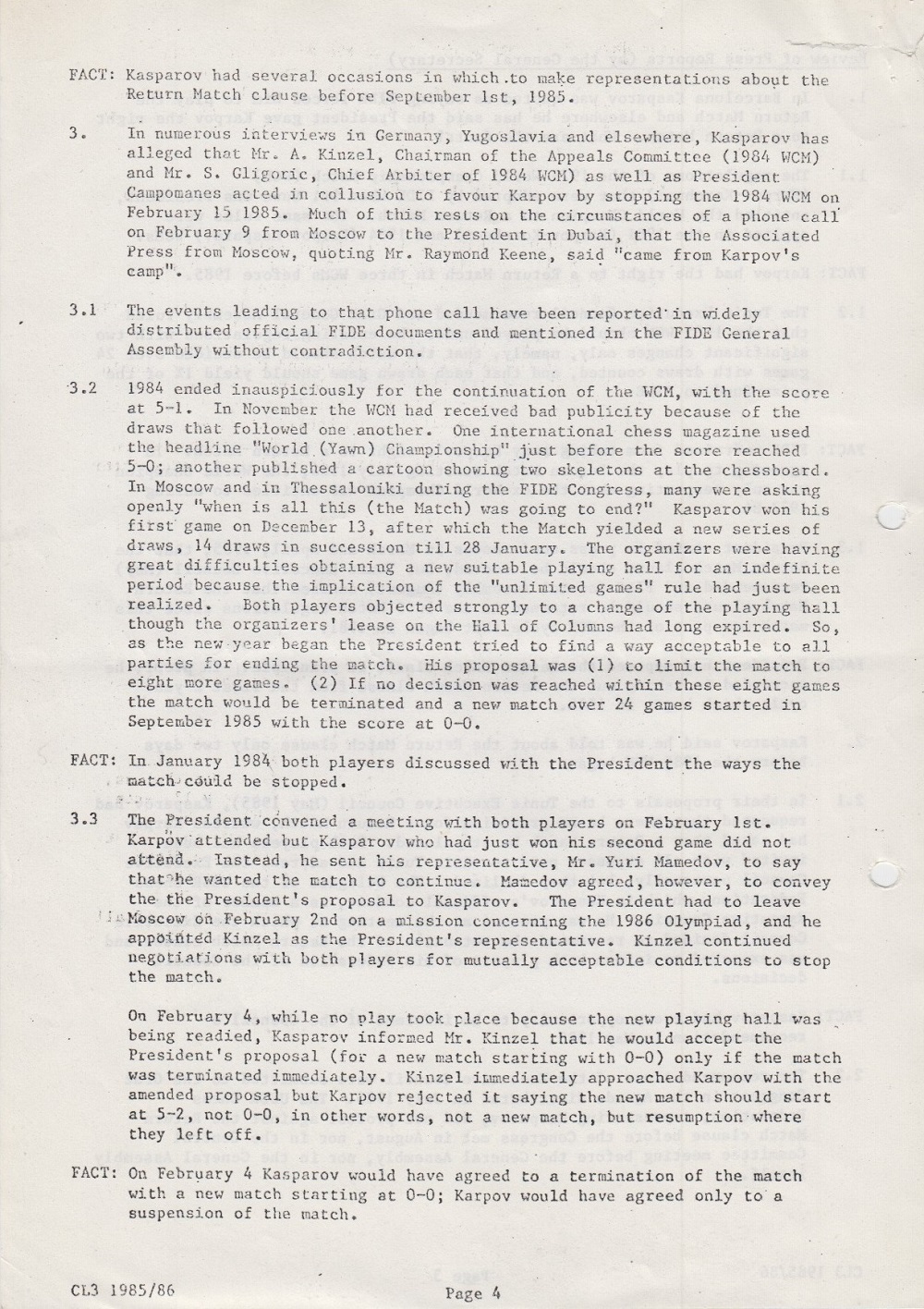
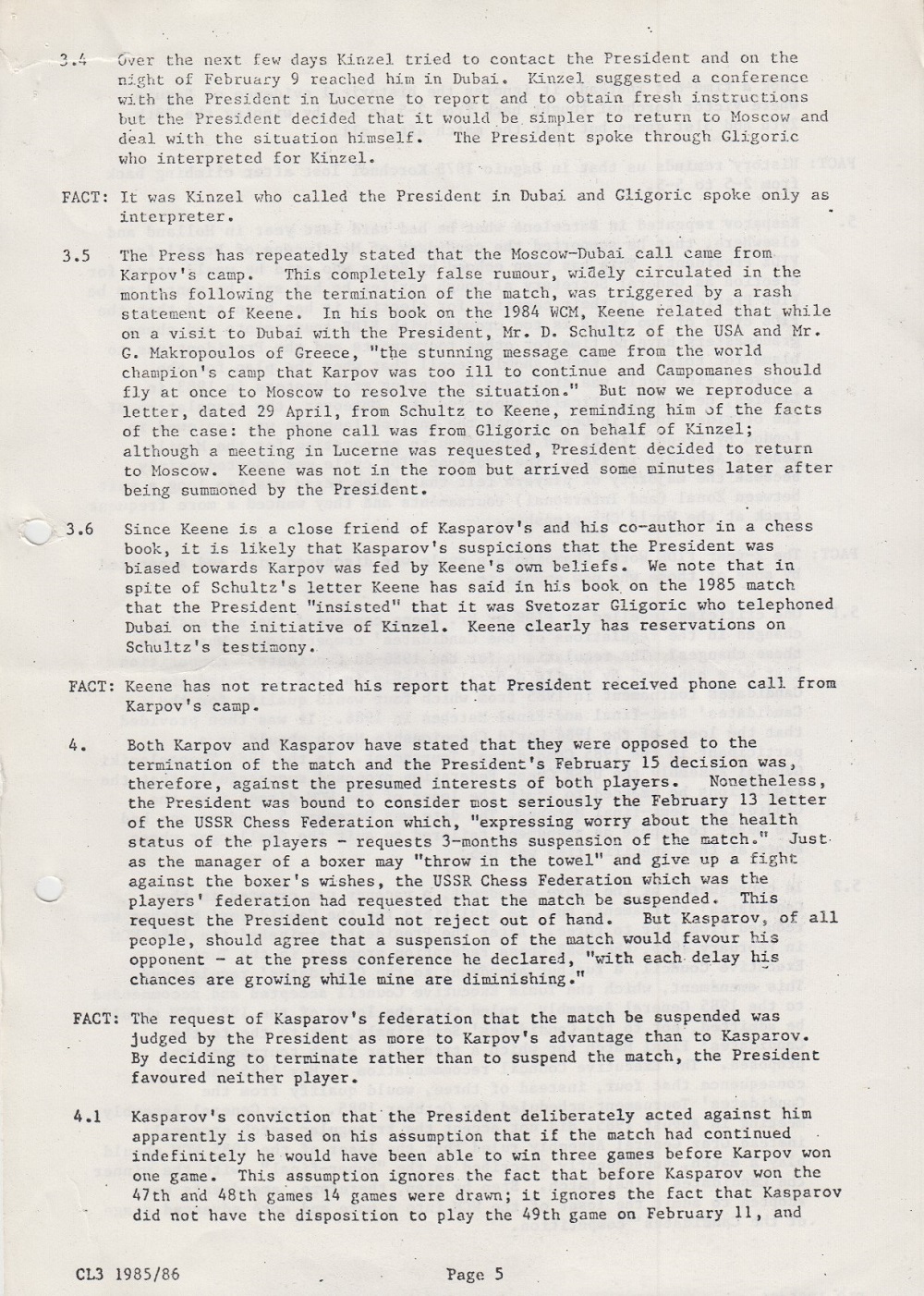
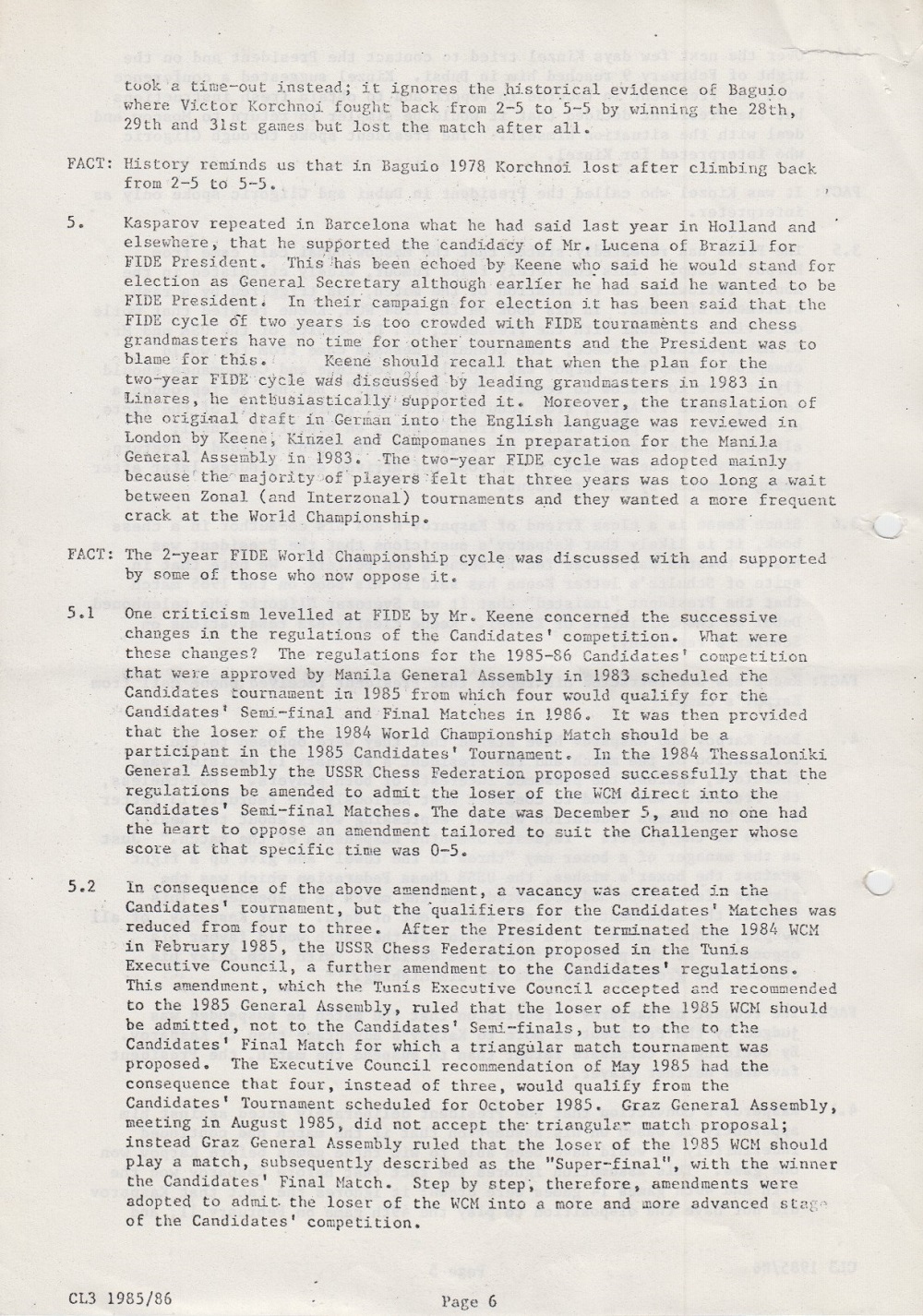
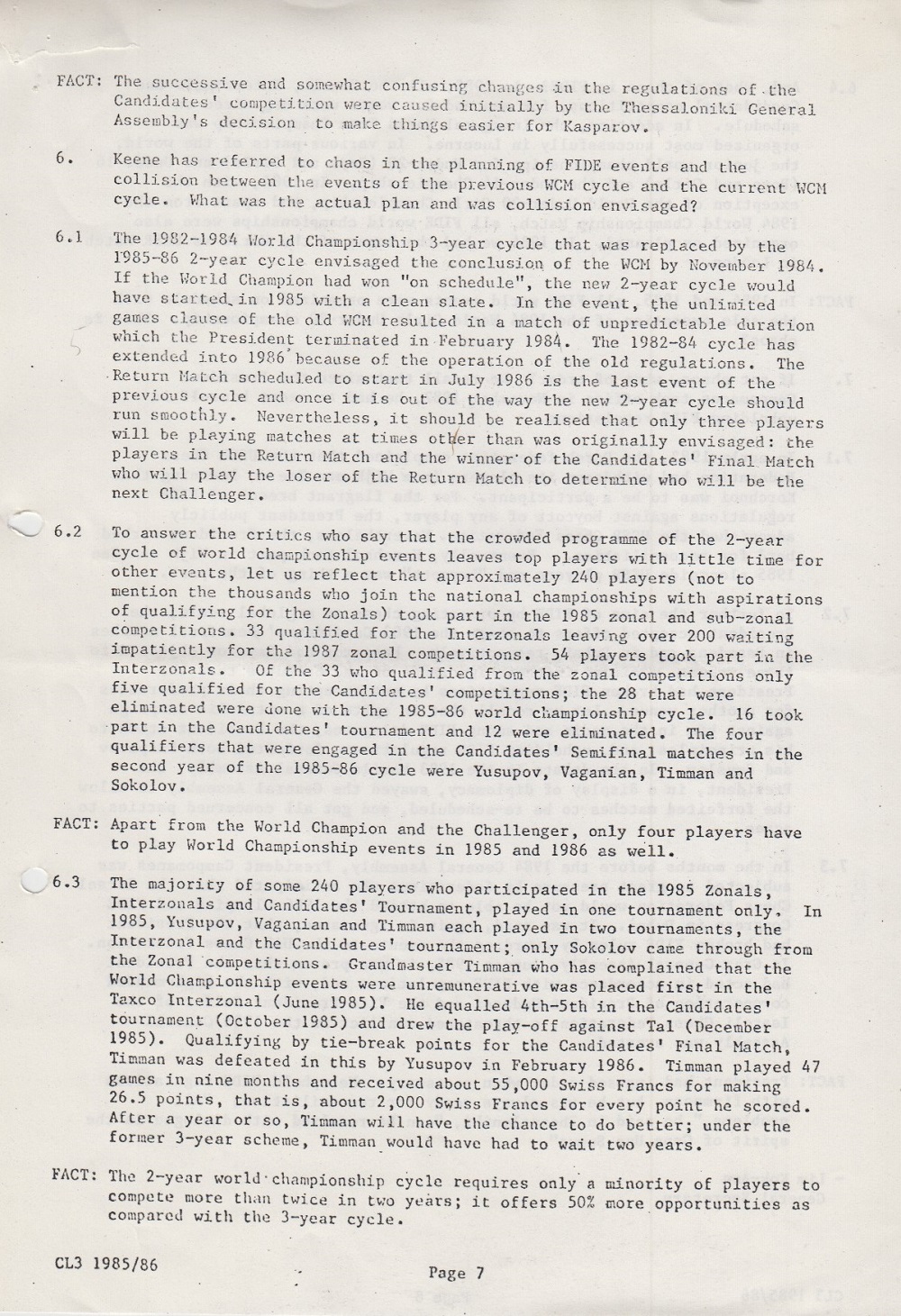
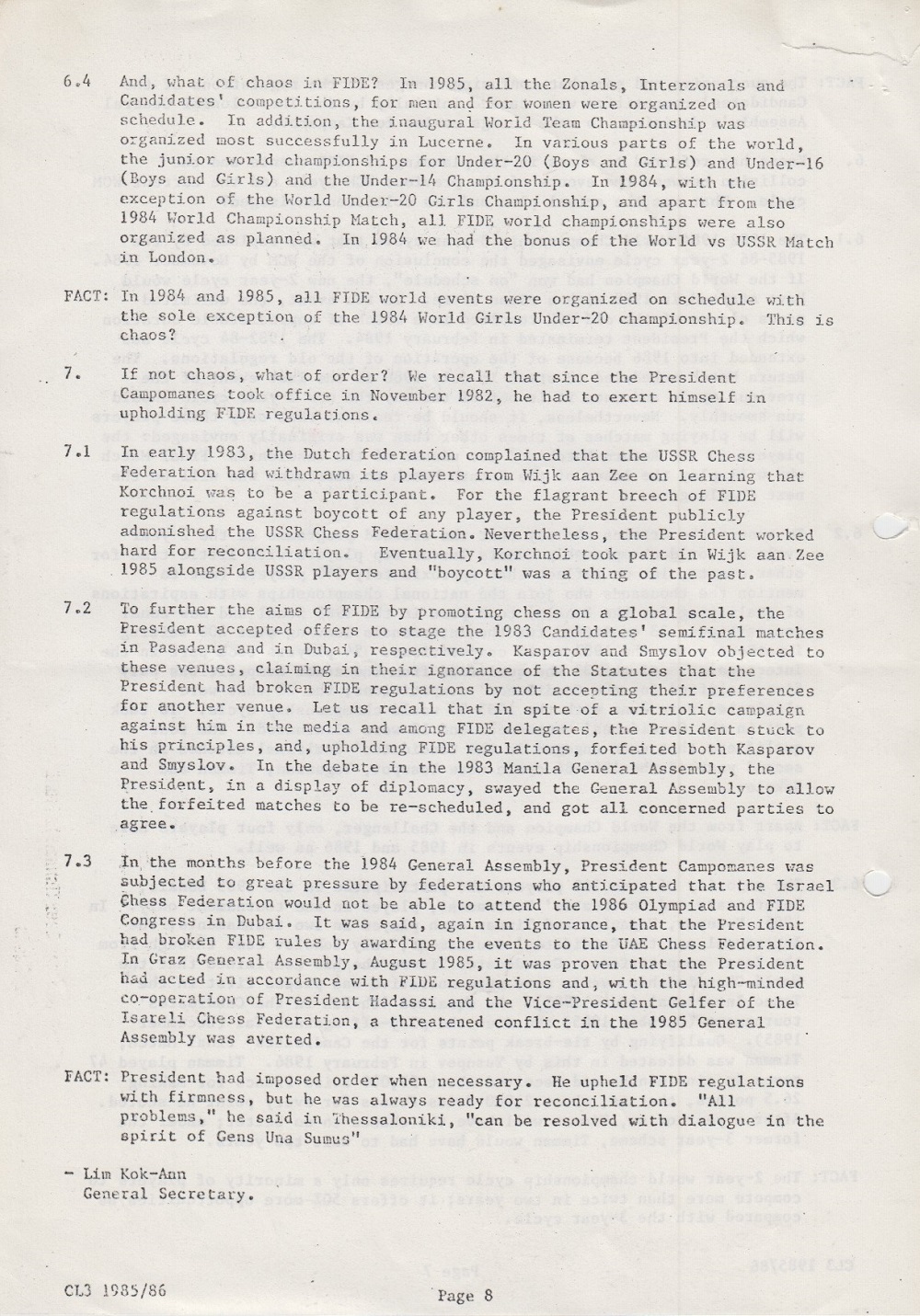
FIDE Facts sheet one above mentioned that Lim Kok Ann’s text was published in the May 1986 BCM, followed by a response from Raymond Keene (pages 188-195 and 204-208 respectively).
The text below appeared on pages 1-2 of the FIDE President’s Circular Letter No. 4 1985/86, dated 28 April 1986:

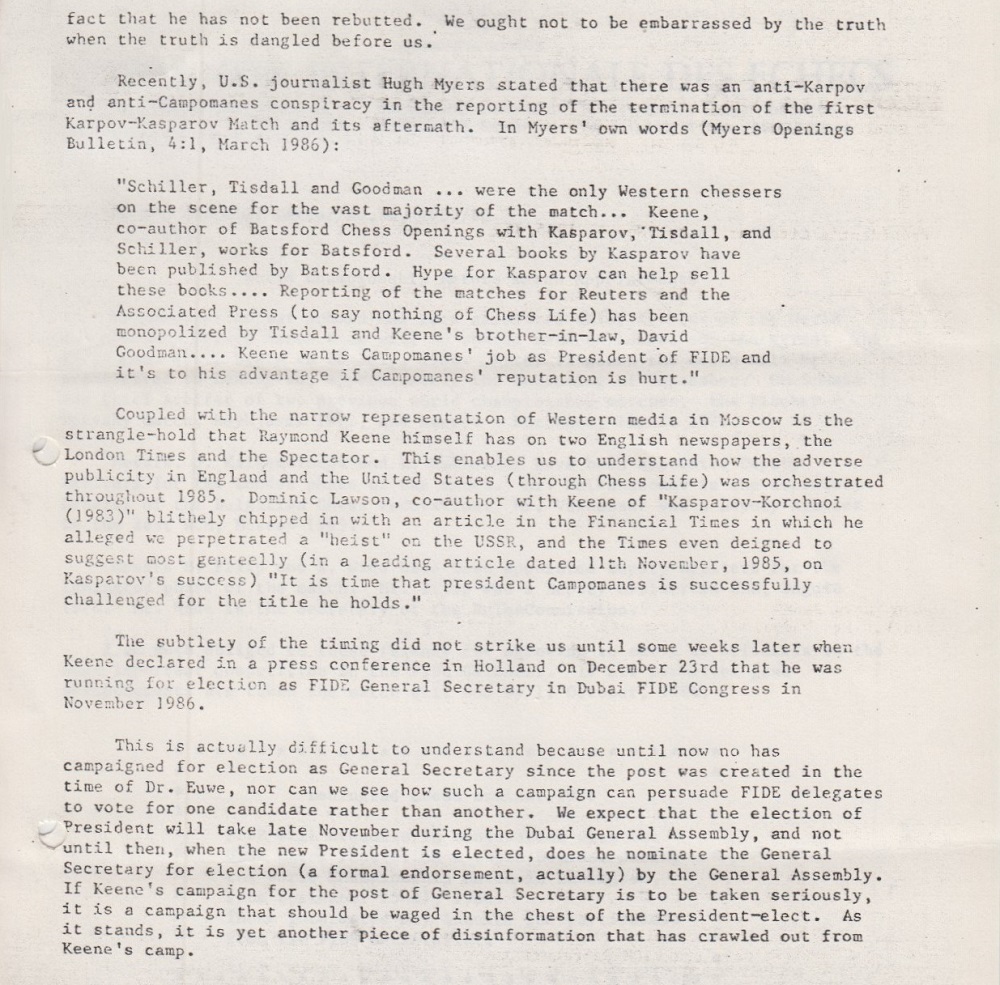
From our feature article on Eric Schiller, A Sorry Case:
On 3 May 2010, the day Florencio Campomanes died, Eric Schiller posted the following message at chessgames.com:
‘An evil man who is not going to be missed. Thoroughly corrupt persecutor of those who wanted chess to move forward. Destroyer of our beloved World Championship.
Some champagne with dinner tonight to wish him good riddance!’

From another chessgames.com page later the same day:

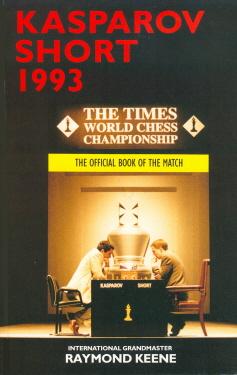
With regard to the interview in your 94/8 issue, Mr Bob Rice’s knowledge of chess and/or sense of fairness may be measured by his assertion on page 9 of the Batsford book on the 1993 Kasparov v Short match:
‘Although the World Championship matches have been arranged by many different organizations, the lineage of the 13 Champions has been recognized by all, including the World Chess Federation (FIDE), a group of national amateur bodies that arranged the last several matches.’
‘Last several’ means ‘last seventeen’.
(Letter from us on pages 8-9 of the 1/1995 New in Chess)
See also The 1936 Munich Chess Olympiad.
To the Chess Notes main page.
To the Archives for other feature articles.
Copyright: Edward Winter. All rights reserved.